Analyzing your competitors is crucial for understanding how to beat them.
In this article, we review the top 16 competitor monitoring tools that can help you stay ahead of your competition.
We go over both paid and free competitive analysis tools to help you find a tool regardless of your budget.
What Are Competitor Monitoring Tools?
Competitor monitoring tools help businesses track and monitor their competitors’ business, marketing, and sales activities.
They can help you:
- Uncover keywords you should target with SEO content
- Optimize your ad campaigns
- Improve your social media marketing and email marketing campaigns
- Find and win over your competition’s dissatisfied customers
Whether you’re looking to monitor your competition’s SEO, paid search, email marketing, or social media marketing efforts—there’s a tool on this list to help you do an effective competitive analysis.
Best Competitor Analysis Tools
Here are our picks for the best tools for doing a competitor analysis:
1. Organic Research
- Best for: Analyzing your competitors’ organic search presence
- Free version available: Yes
- Pricing: Pro ($129.95/month); Guru ($249.95/month); Business ($499.95/month)
You can use the Organic Research tool to discover websites you’re competing with on search engine results pages (SERPs), learn which keywords they rank for, and how much traffic they’re generating from organic search.
To get started, enter your domain in the search box and click the “Search” button.
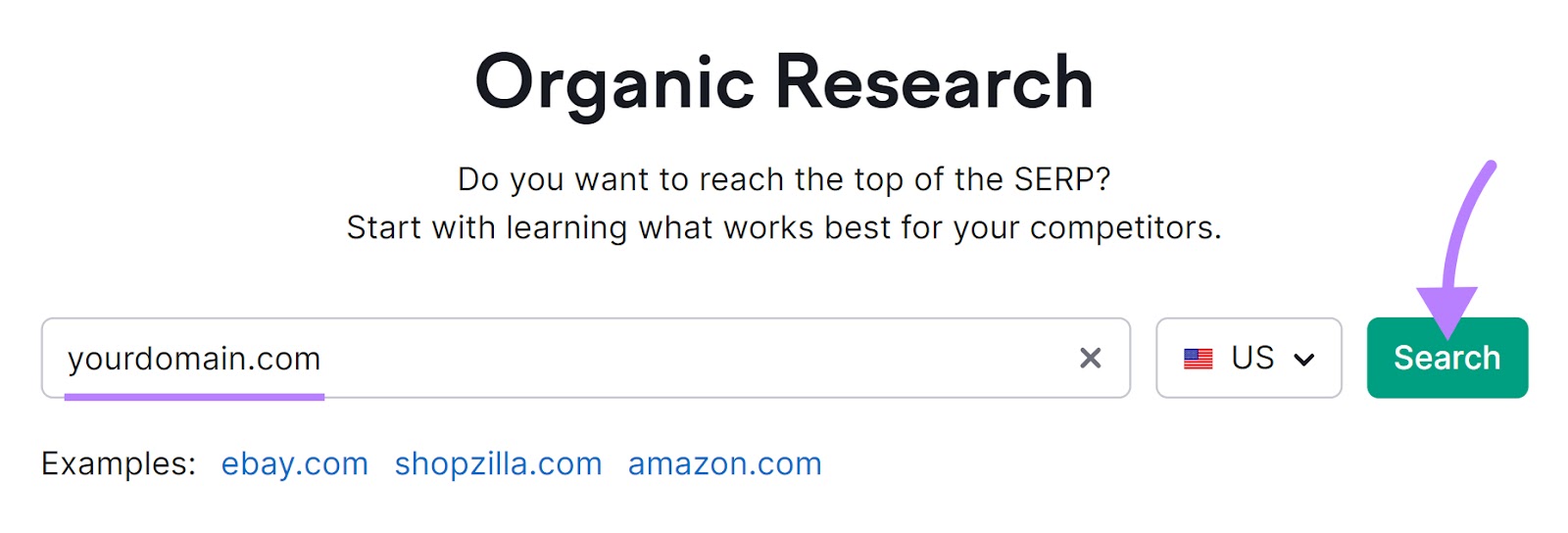
Click the “Competitors” tab.
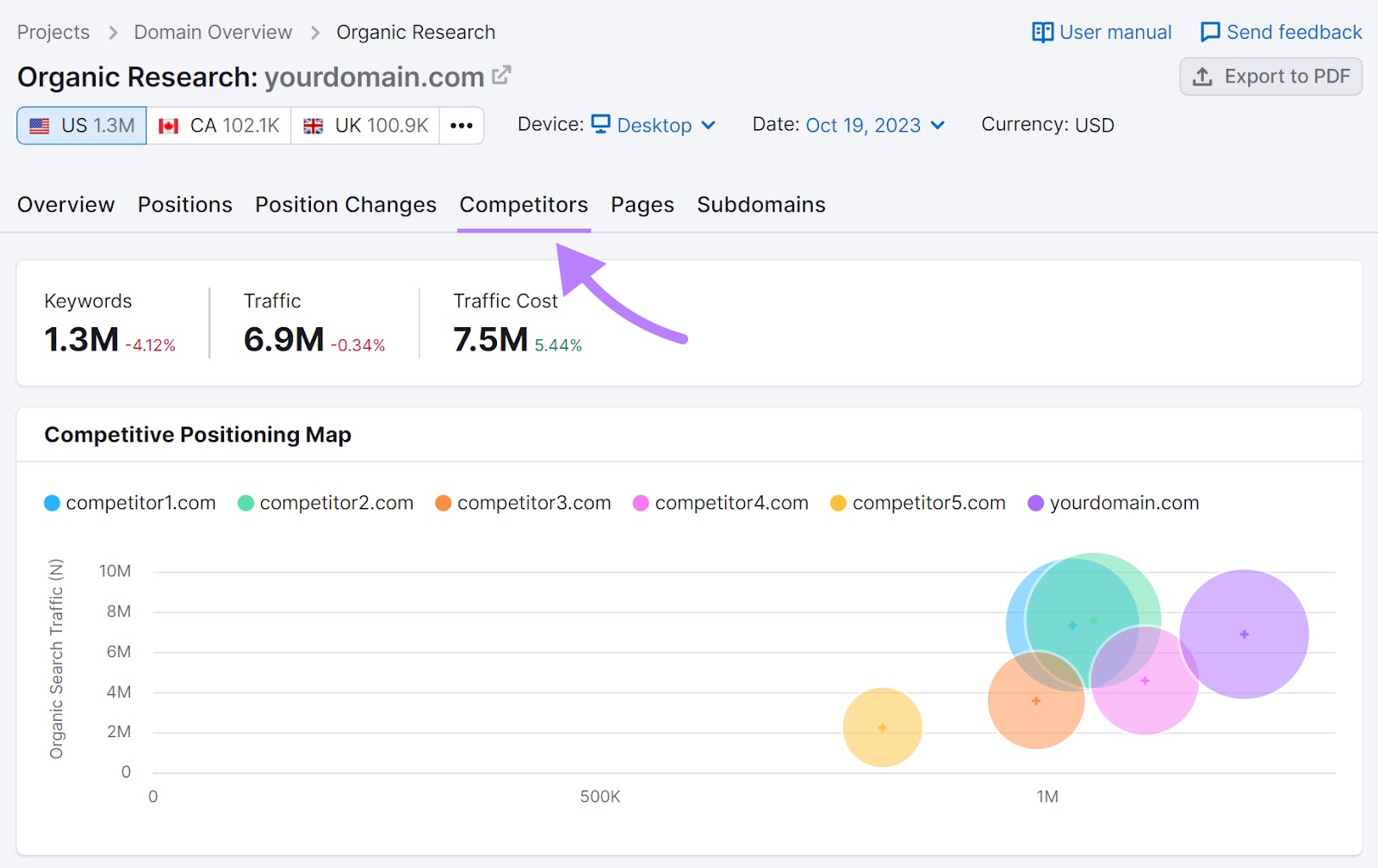
Here, you’ll get a complete list of websites you’re competing with in the SERPs. Plus, the number of keywords they rank for, the traffic they generate, and more.
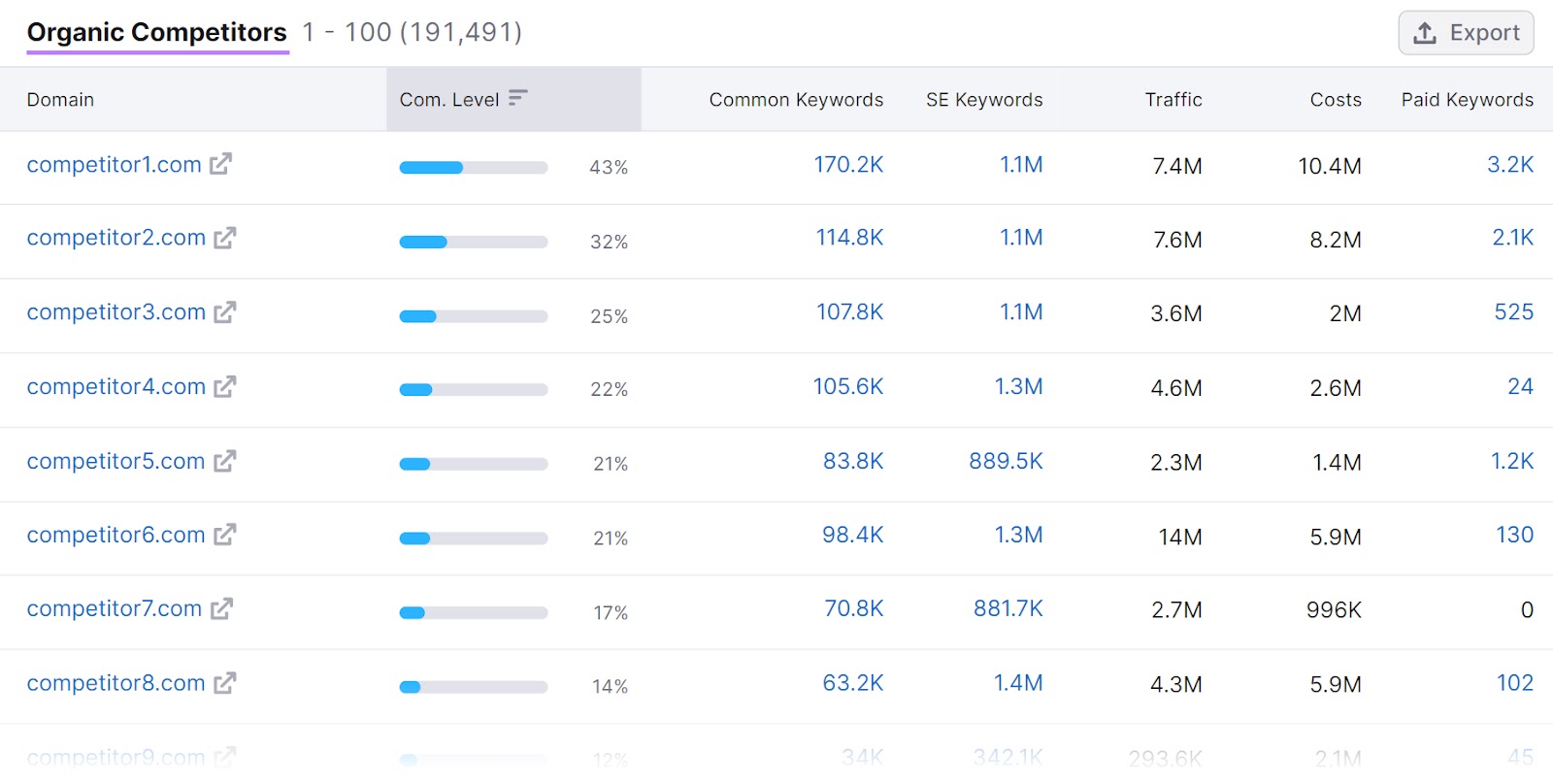
If you’d like to see a list of all the keywords a competitor ranks for, click on the number in the “SE Keywords” column.
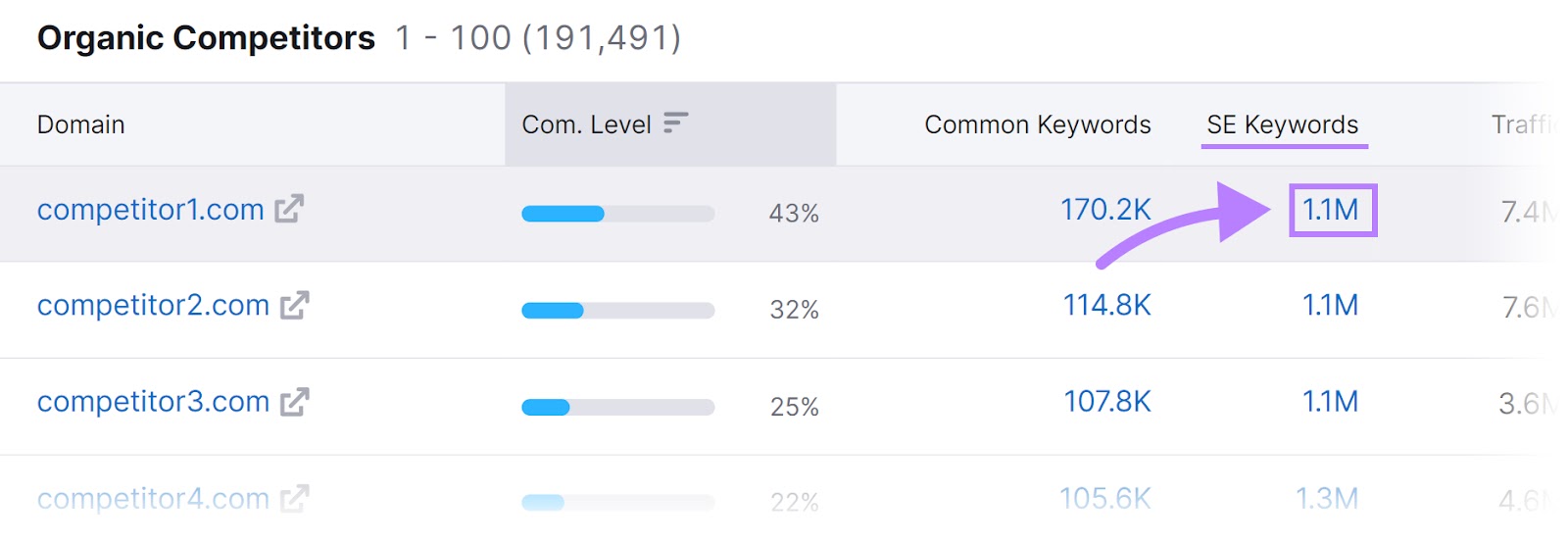
Here, you can see all the keywords the competing website currently ranks for on Google, along with keyword position, keyword difficulty (a metric that indicates how difficult it is to rank in the top 10 for a given keyword), traffic, and more.
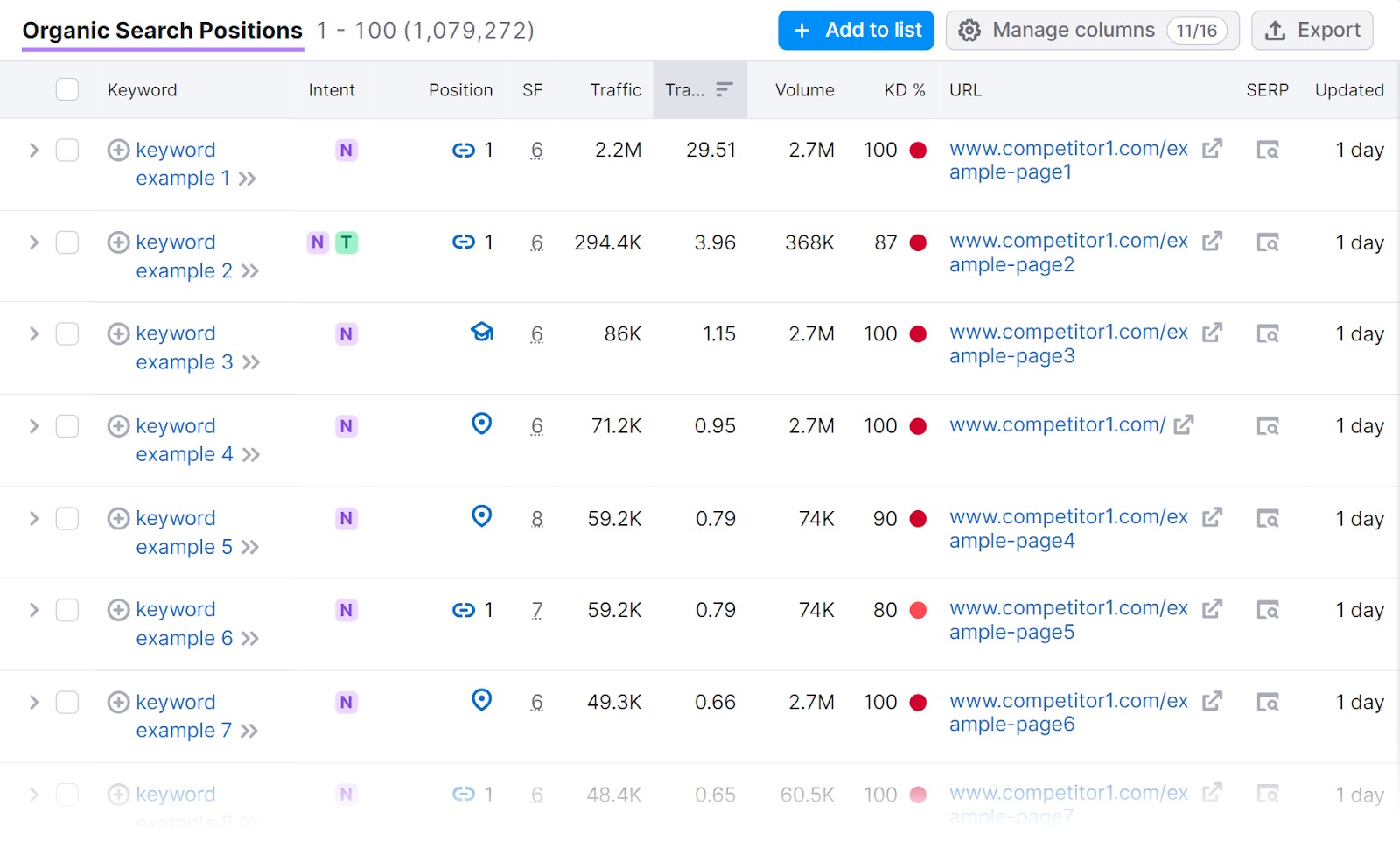
What We Like
You gain access to all of the keywords your competition ranks for, thanks to the extensive Domain Analytics database. Which allows you to get a wide array of keyword ideas for your website.
2. Traffic Analytics
- Best for: Benchmarking your traffic numbers against competitors
- Free version available: Yes
- Pricing: Pro ($129.95/month); Guru ($249.95/month); Business ($499.95/month) + $200/month/user
Traffic Analytics lets you benchmark your website traffic against your competition and compare metrics like unique visitors, average visit duration, and bounce rate.
You can also use it to identify your competitors’ top traffic sources and their most popular content.
Here’s how to use it:
Open the tool, enter up to five competitors’ domains, and hit the “Analyze” button.
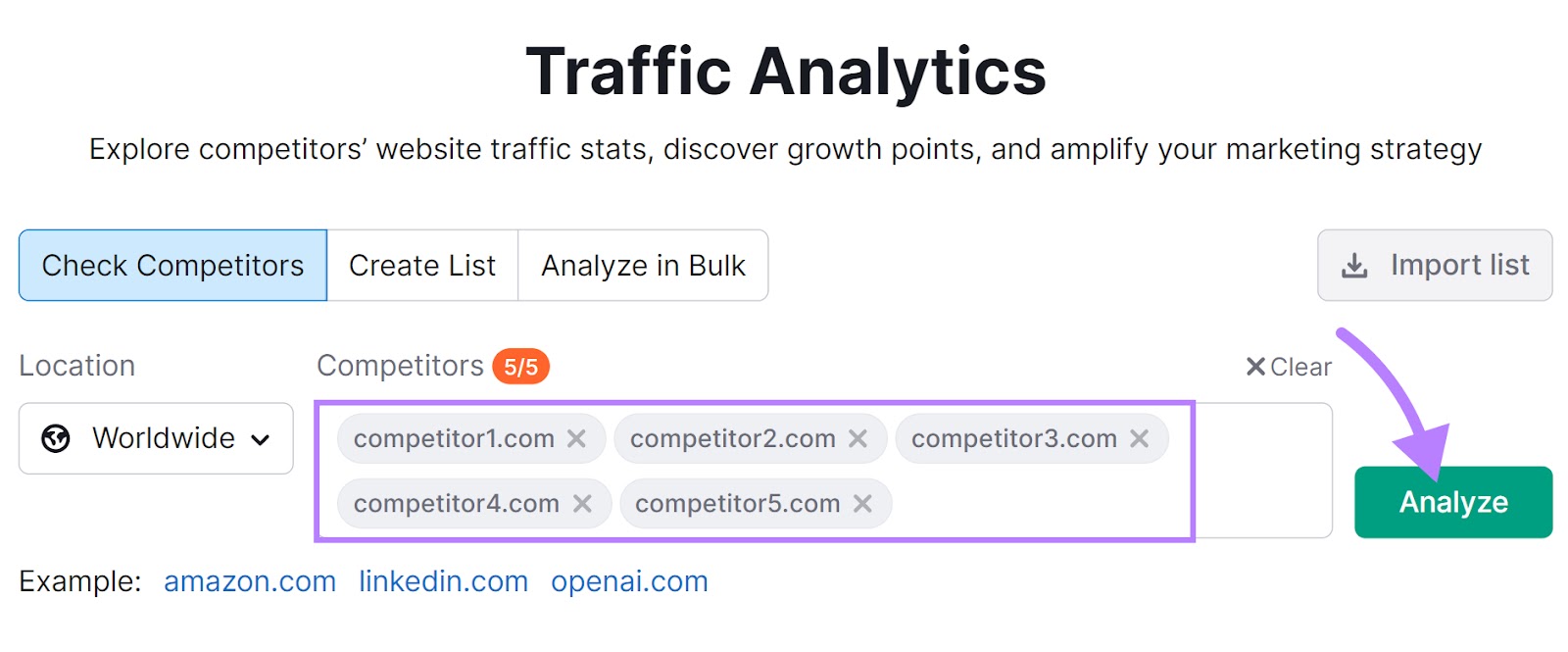
The tool will then generate a report with detailed insights on your competitors’ web traffic.
In the “Overview” tab, you can see a high-level overview of your competition’s traffic numbers, including total visits, unique visitors, purchase conversion, pages per visit, average visit duration, and bounce rate.
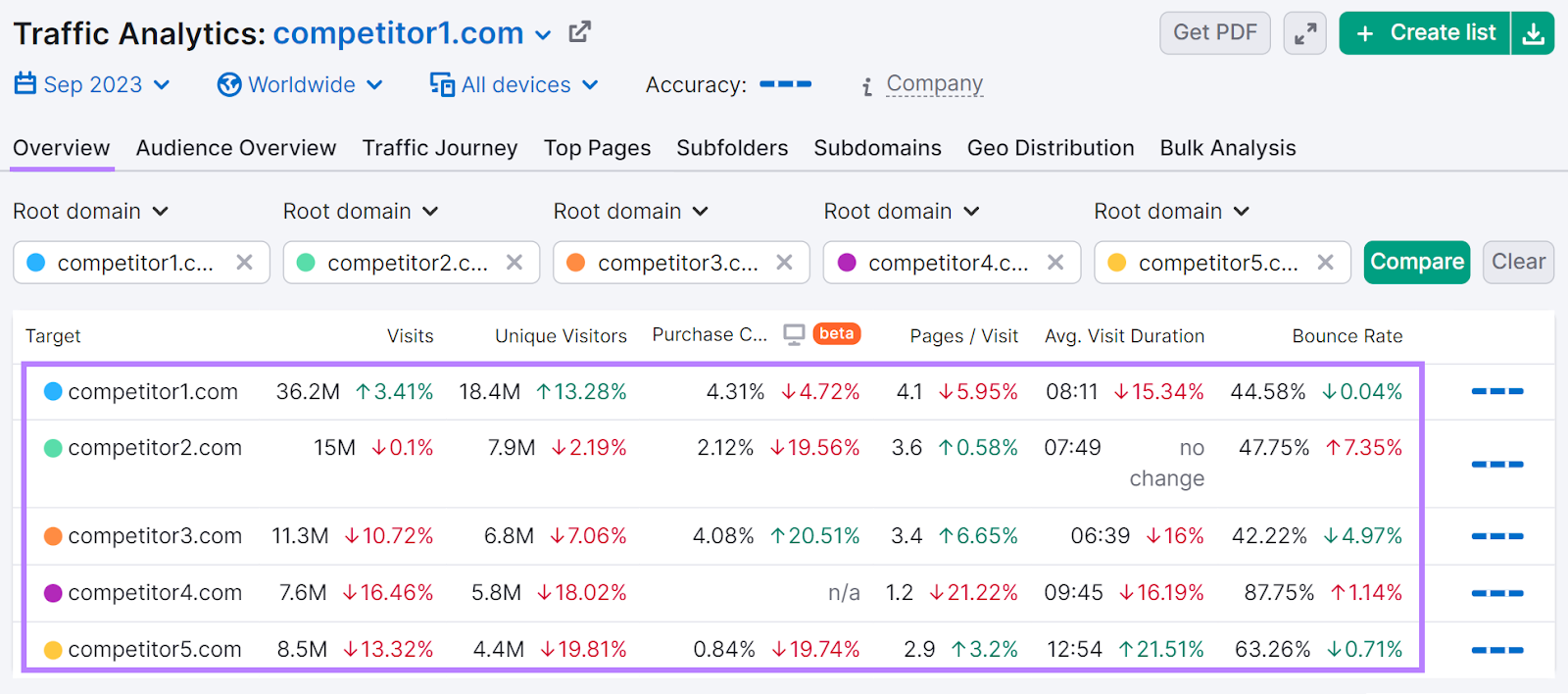
Scroll down, and you’ll see a graphic showing your competitors’ top traffic channels.
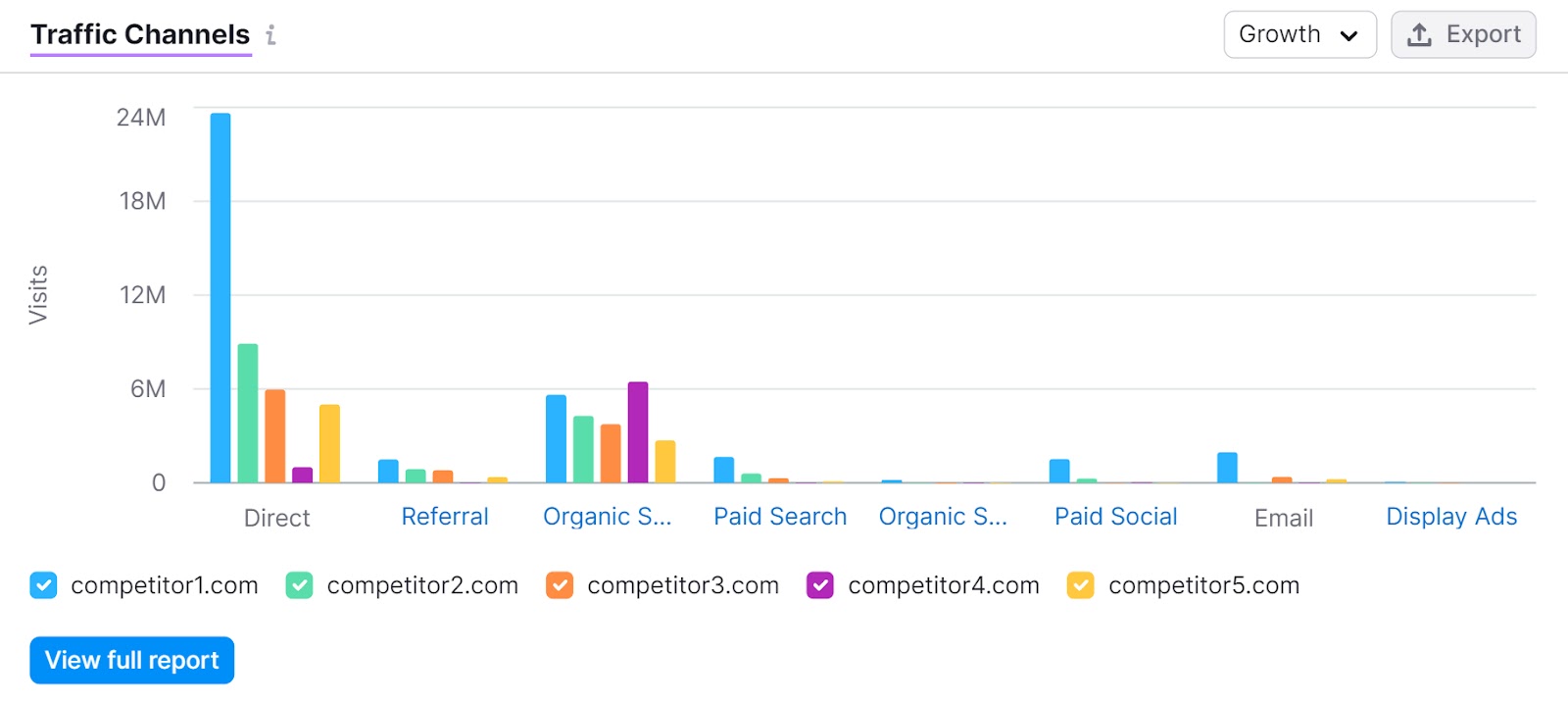
If you’d like to see a competitor’s most popular content, click on the “Top Pages” tab.
Here, you can see their most popular pages. Along with how much traffic they’re generating from different sources.
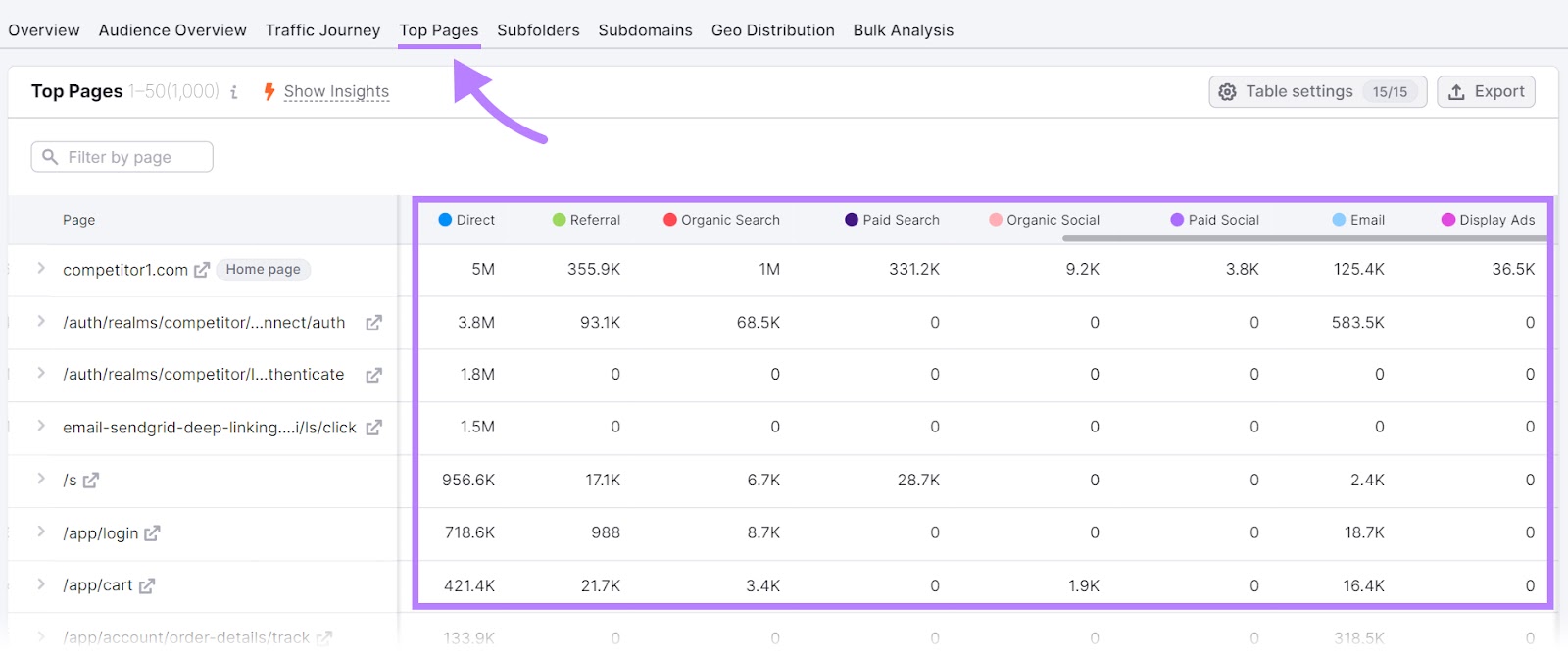
What We Like
Traffic Analytics gives you all the information you need to analyze your competitors’ traffic. And uncover new traffic sources you could focus on.
3. Market Explorer
- Best for: Getting a deeper understanding of your target market and key players
- Free version available: Yes
- Pricing: Pro ($129.95/month); Guru ($249.95/month); Business ($499.95/month) + $200/month/user
You can use the Market Explorer tool to uncover the top competitors in your space, compare online market shares and growth rates, and analyze seasonal trends.
It can also help you assess the costs of entering a new market.
To start, enter your competitors’ domains. Then, enter a name for your list and click the “Create and analyze” button.
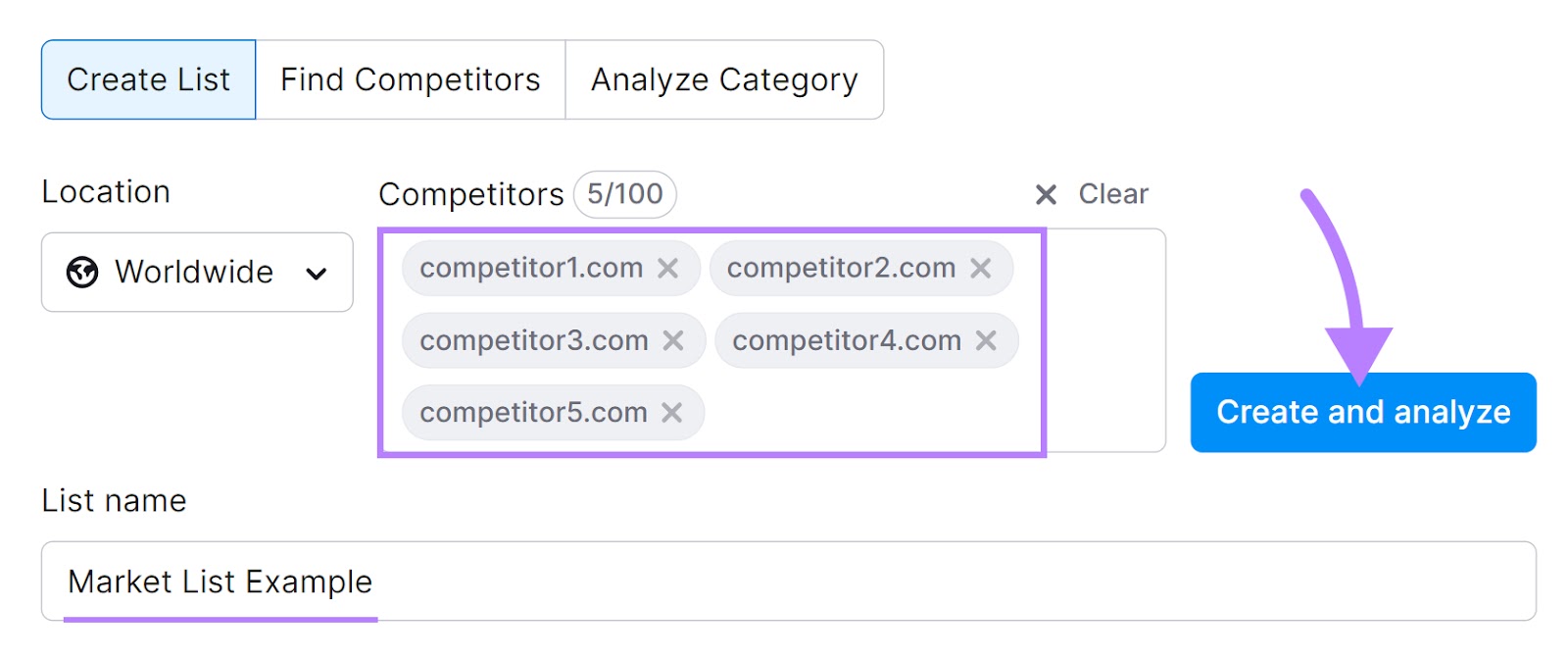
Alternatively, you can click the “Find Competitors” tab, enter your domain name, and click “Research a market.” The tool will then generate a report based on your target market.
In the “Overview” tab, you’ll see a market summary showing the key players in your space, the total market size, market traffic, and more.
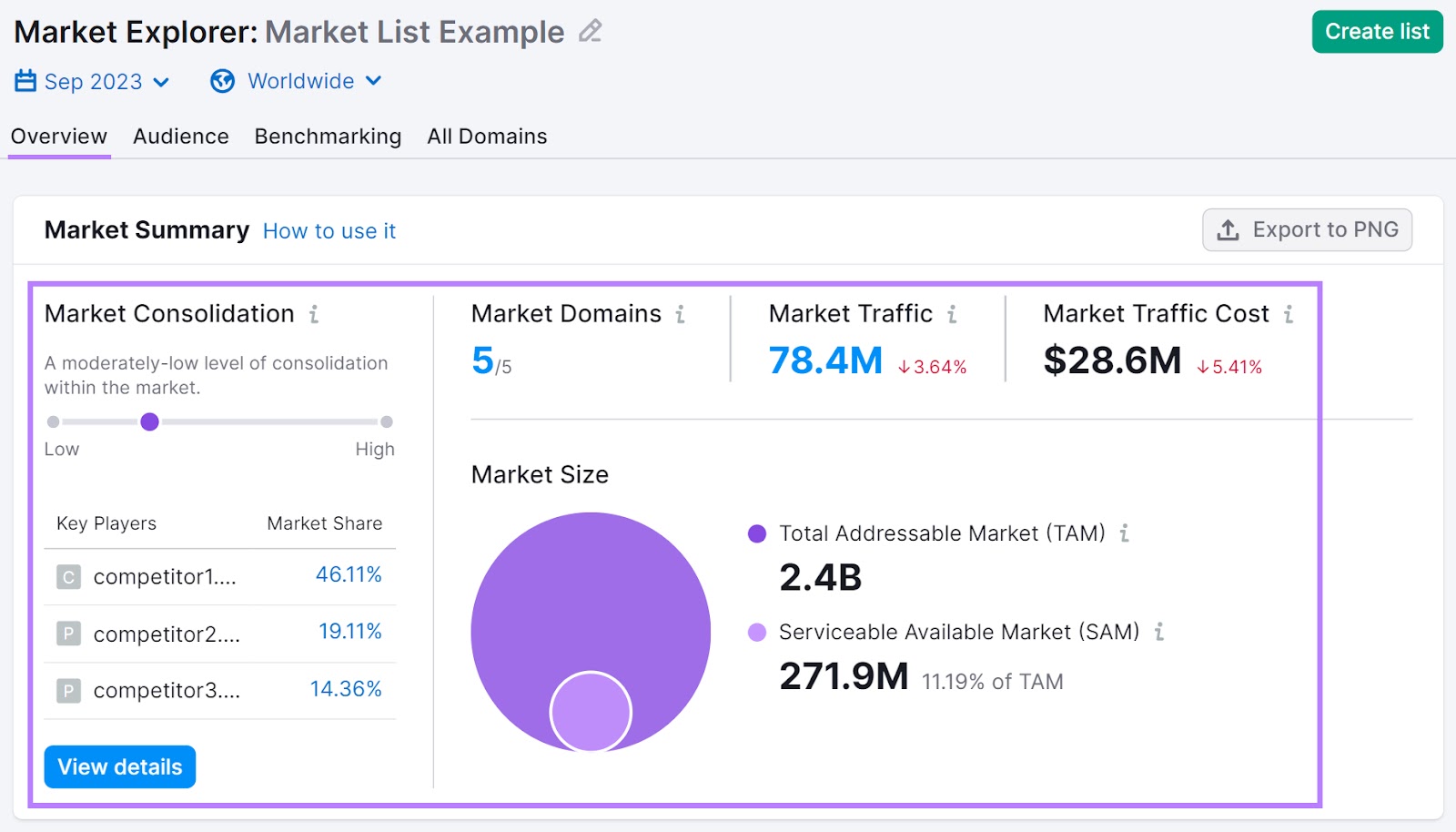
If you scroll further down to the “Domain vs Market Dynamics” section, you’ll see how each competing domain performs relative to the market as a whole.
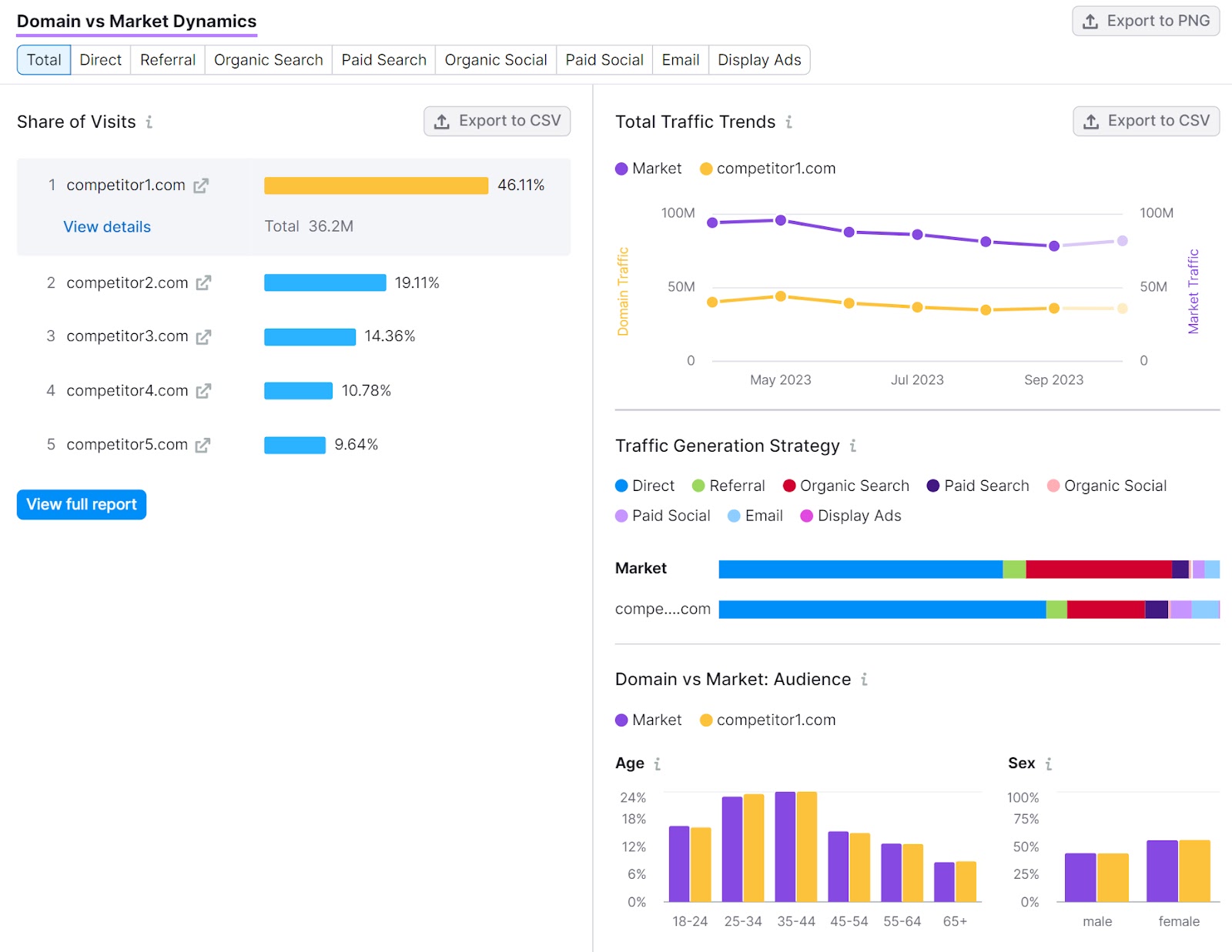
And the tool gives you access to a few other useful reports.
The “Audience” report provides insights into your market’s target audience, including information about demographics, socioeconomics, and behavior.
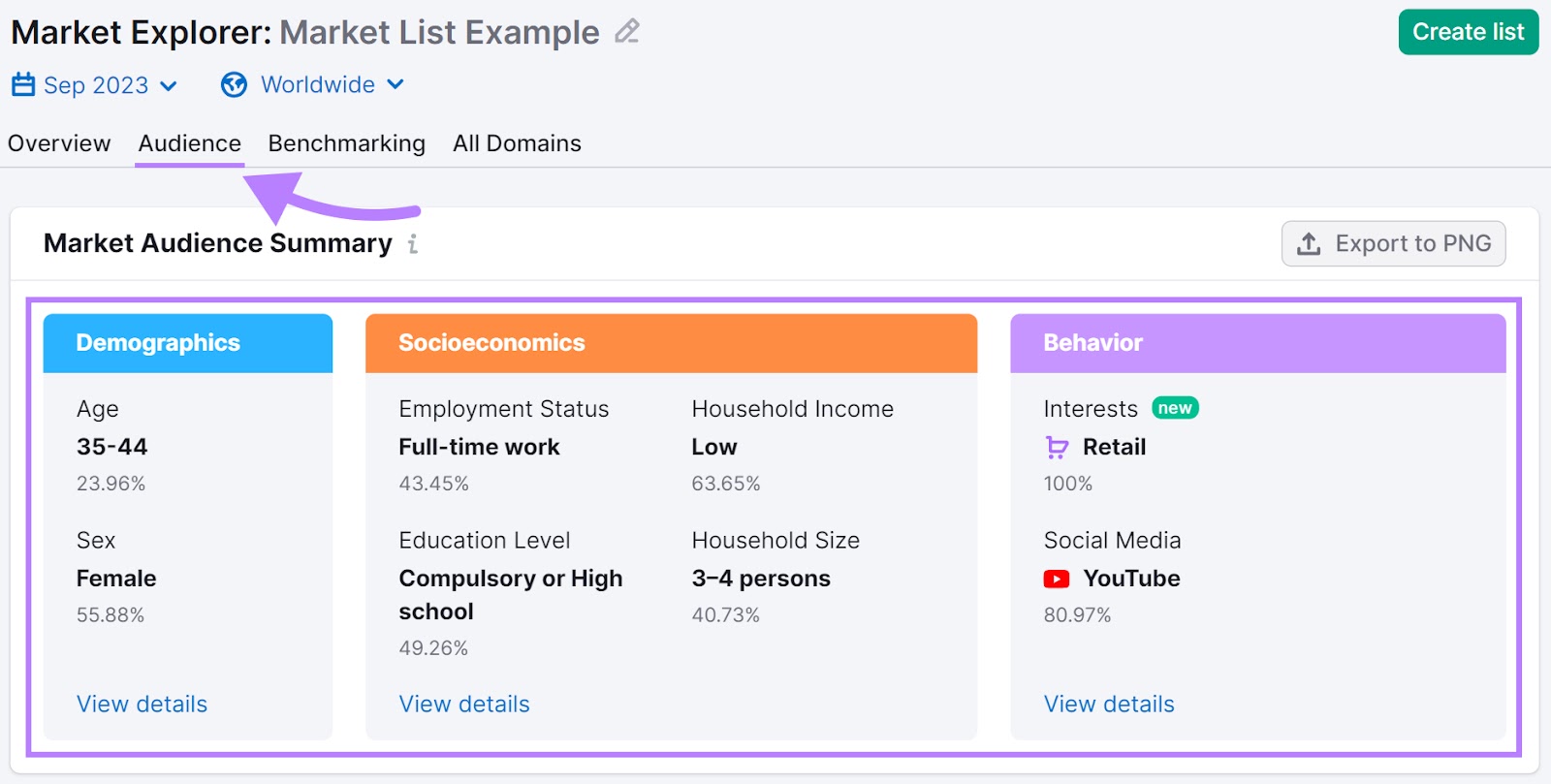
There’s also the “Benchmarking” report, which allows you to compare the performance of up to five competitors against the overall market.
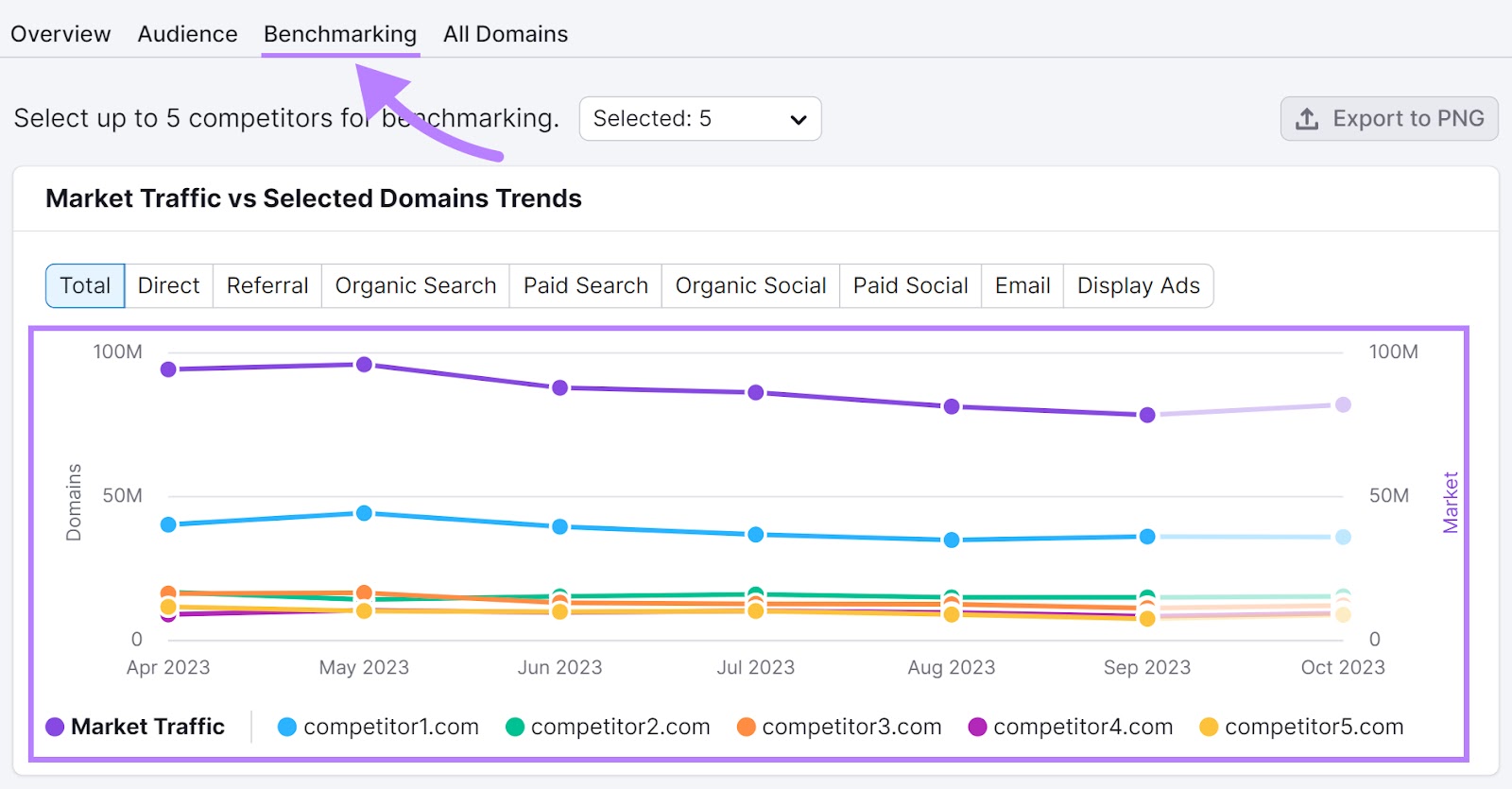
Finally, the “All Domains” report lets you analyze your competitors’ website traffic and uncover their traffic acquisition channels.
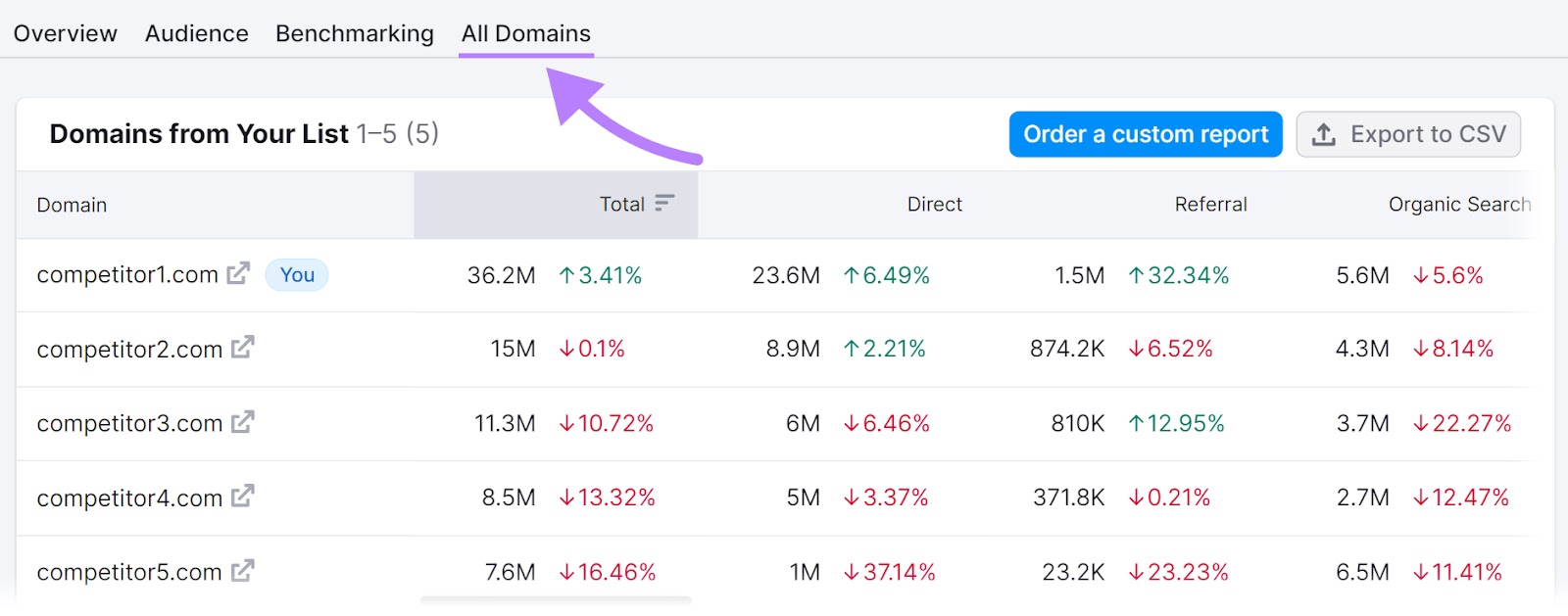
What We Like
The tool gives you a high-level overview of your target market, along with key players and competitors. Plus, benchmarks for traffic performance.
4. Advertising Research
- Best for: Analyzing your competitors’ paid search strategy and ad campaigns
- Free version available: Yes
- Pricing: Pro ($129.95/month); Guru ($249.95/month); Business ($499.95/month)
The Advertising Research tool lets you see and analyze all your competitors’ paid search ads. And allows you to:
- Get an estimate of your competitors’ monthly ad spend
- See how much traffic they’re driving through pay-per-click (PPC) search ads
- Learn which search terms they’re bidding on
- Review their ad copy and landing pages
Here’s how to use it:
On the main tool page, enter your competitor’s domain in the search box and click “Search.”

The tool will then generate a report outlining your competitor’s advertising activities.
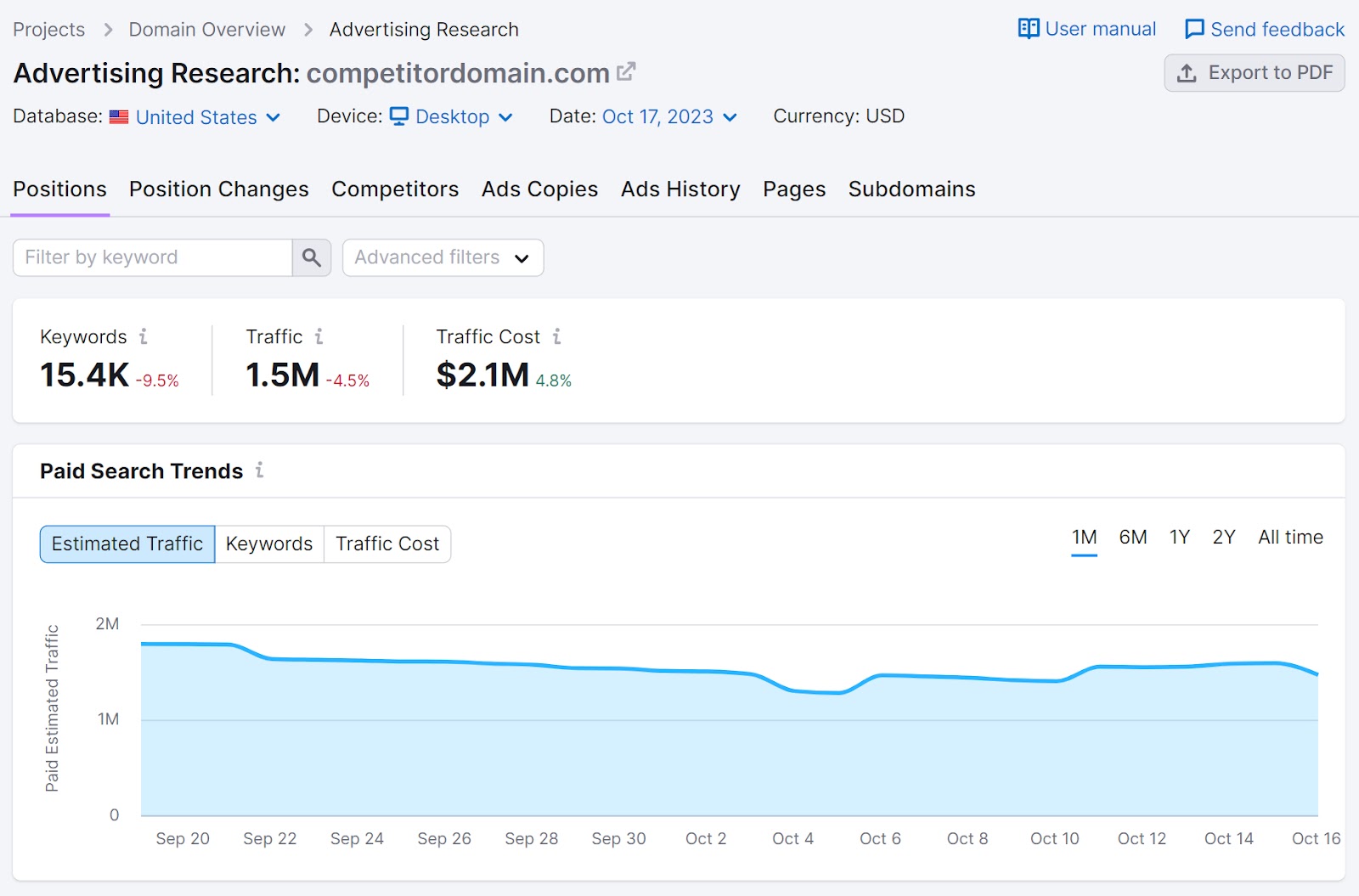
On the “Positions” tab, you’ll see the total number of keywords your competitor is targeting through their paid advertising campaigns, the total traffic they’re generating, and the estimated traffic cost.

If you scroll further down, you’ll see a list of all the keywords your competitor is targeting in their PPC search campaigns.
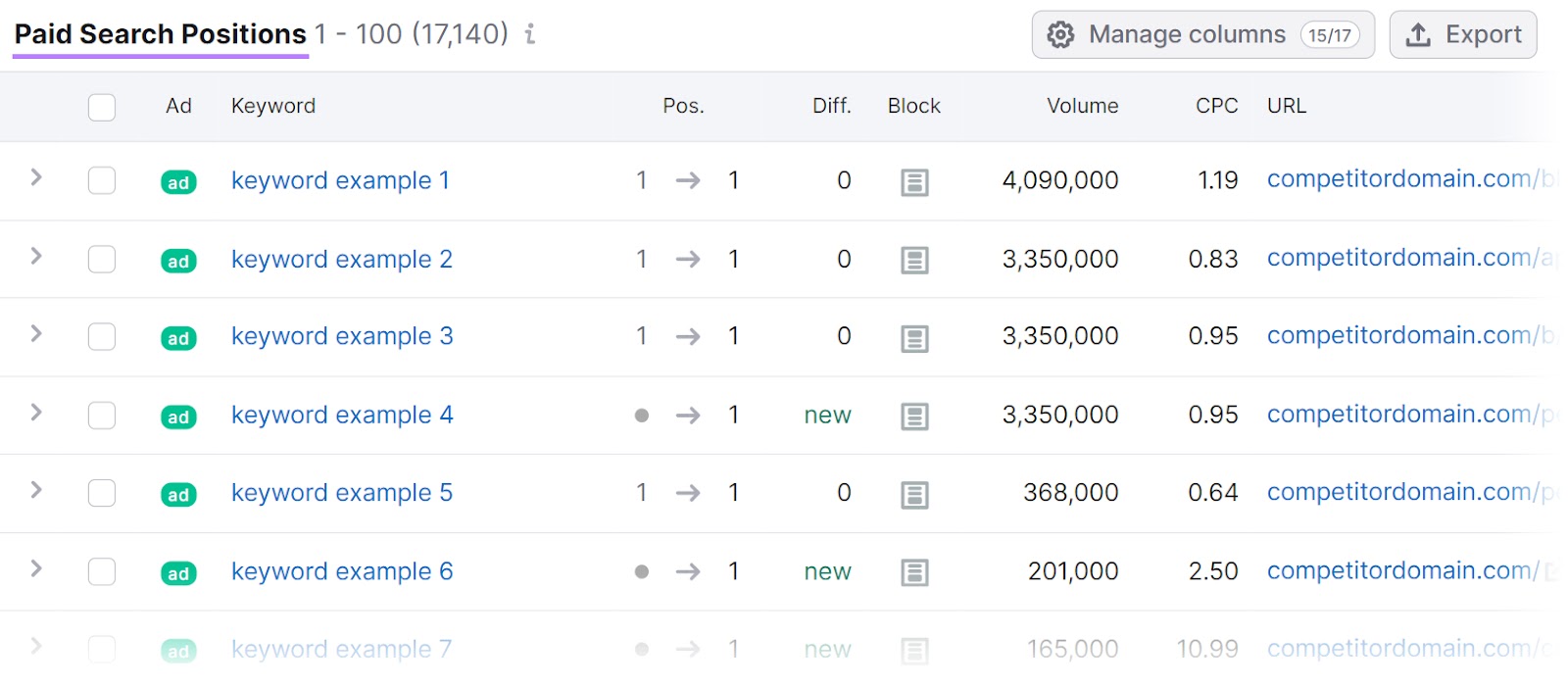
You can click the “Ads Copies” tab to review your competitor’s ad copy.
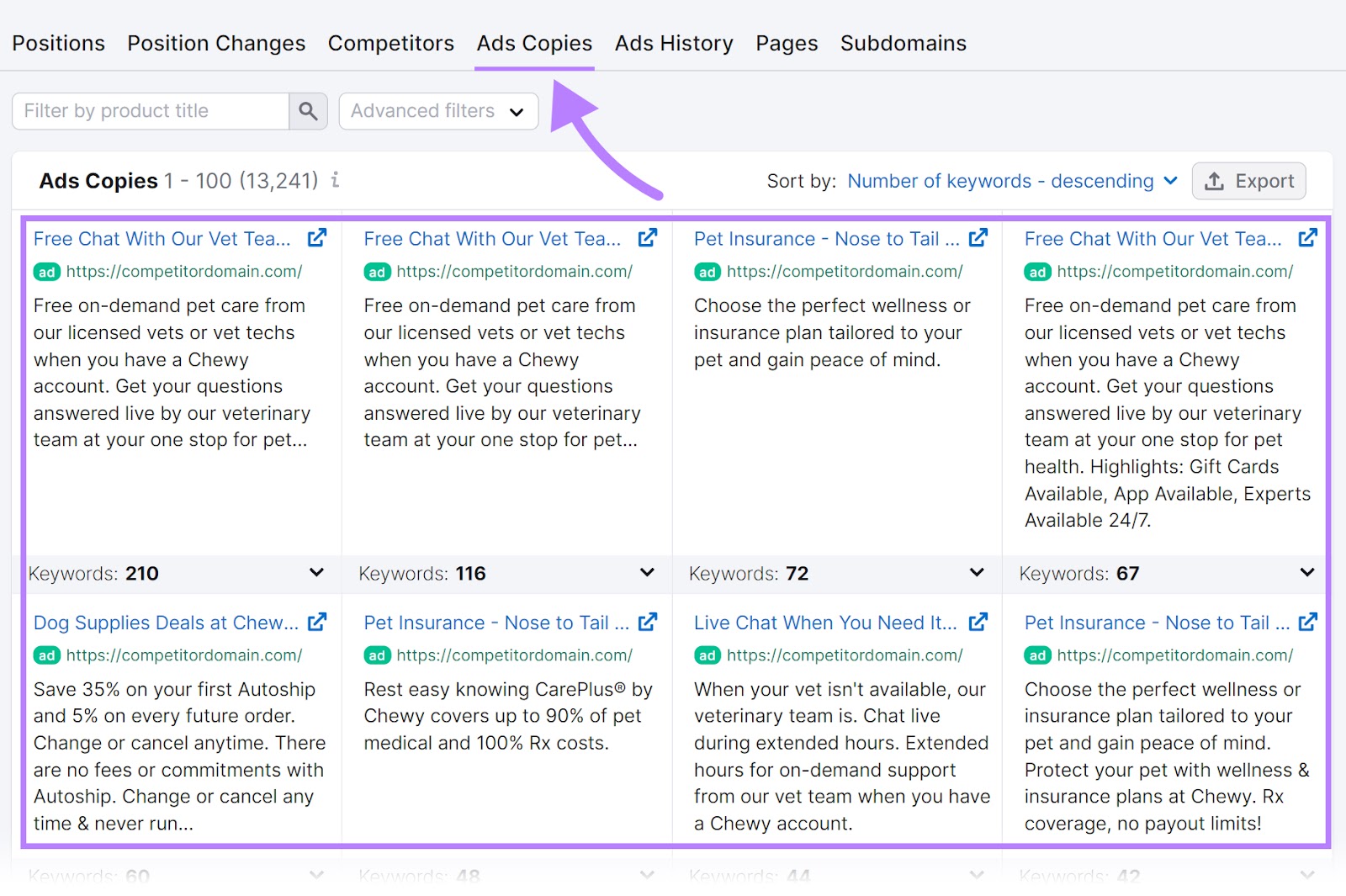
If you’d like to check out their landing pages, click on the “Pages” tab.
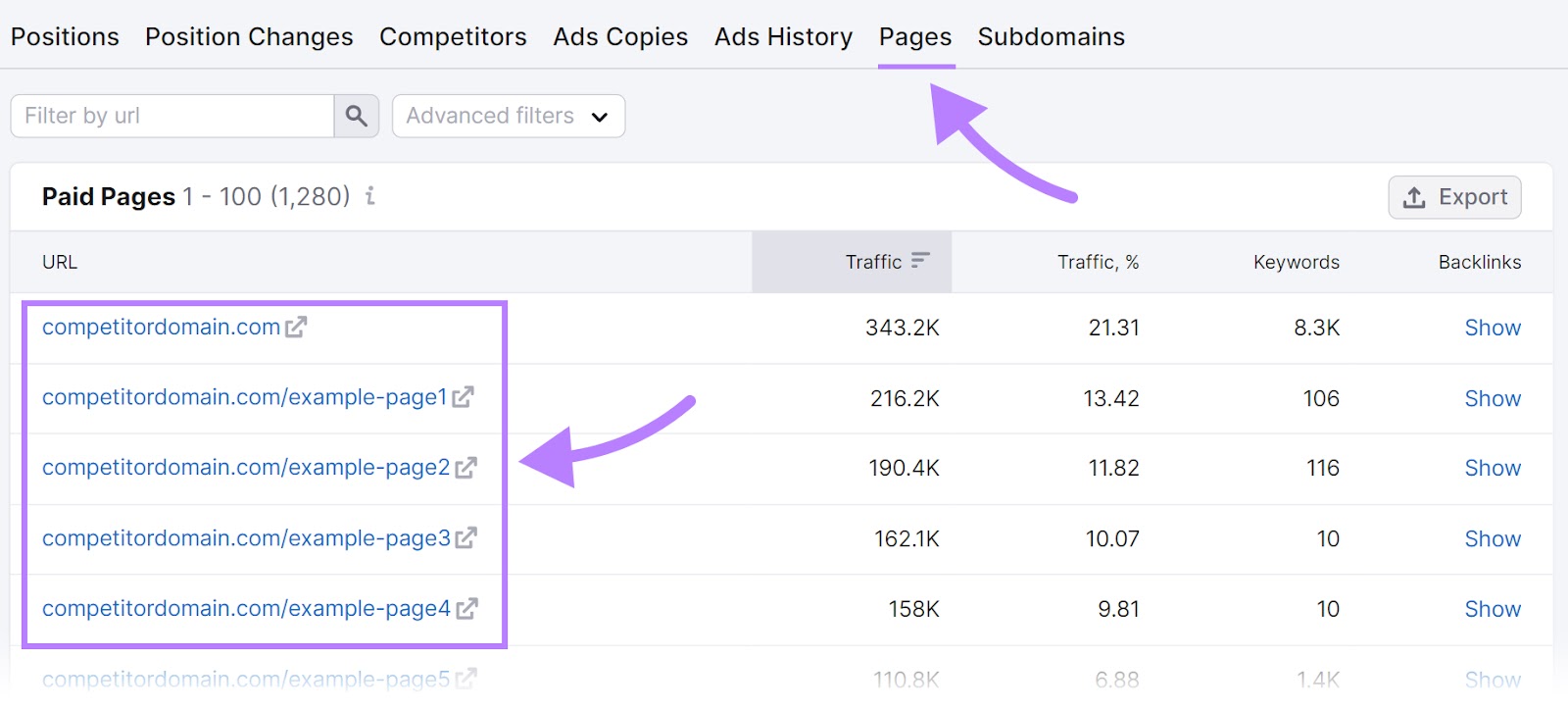
You can also use the Advertising Research tool to uncover more competitors you should keep an eye on. All you need to do is click the “Competitors” tab to see a list of your competitors in paid search.
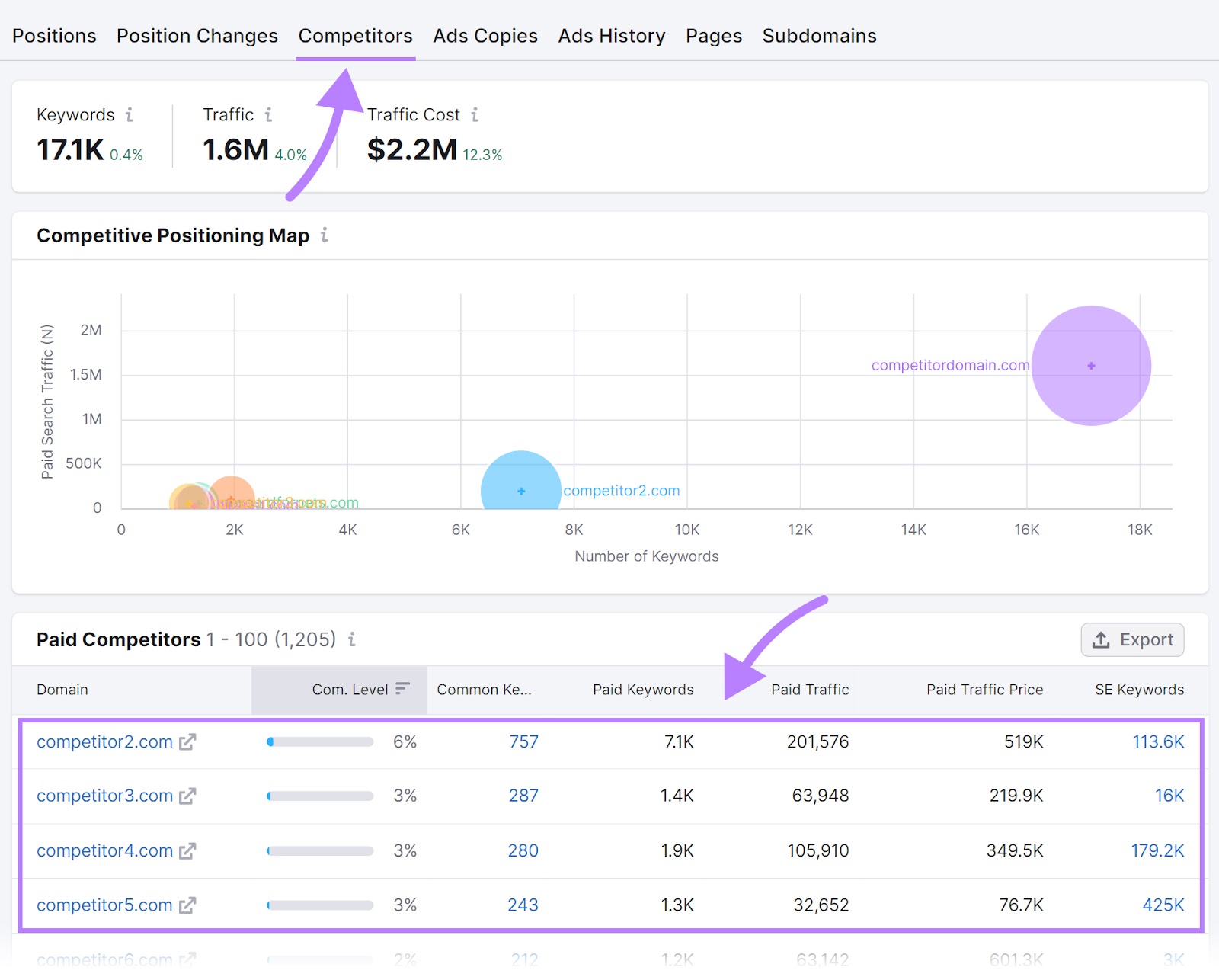
What We Like
This tool gives you the ability to review your competitors’ ads and landing pages, which allows you to see exactly what’s working for them. So you can emulate it for your own advertising campaigns.
5. Keyword Gap
- Best for: Researching your competitors’ keyword rankings to uncover the best keywords you should target with your content
- Free version available: Yes
- Pricing: Pro ($129.95/month); Guru ($249.95/month); Business ($499.95/month)
With the Keyword Gap tool, you can compare your keyword profile to the keyword profiles of up to four competitors to uncover valuable terms your competition is ranking for but you aren’t.
Here’s how to do it:
Open the tool and enter your domain and up to four competing domains. Then, click the “Compare” button.
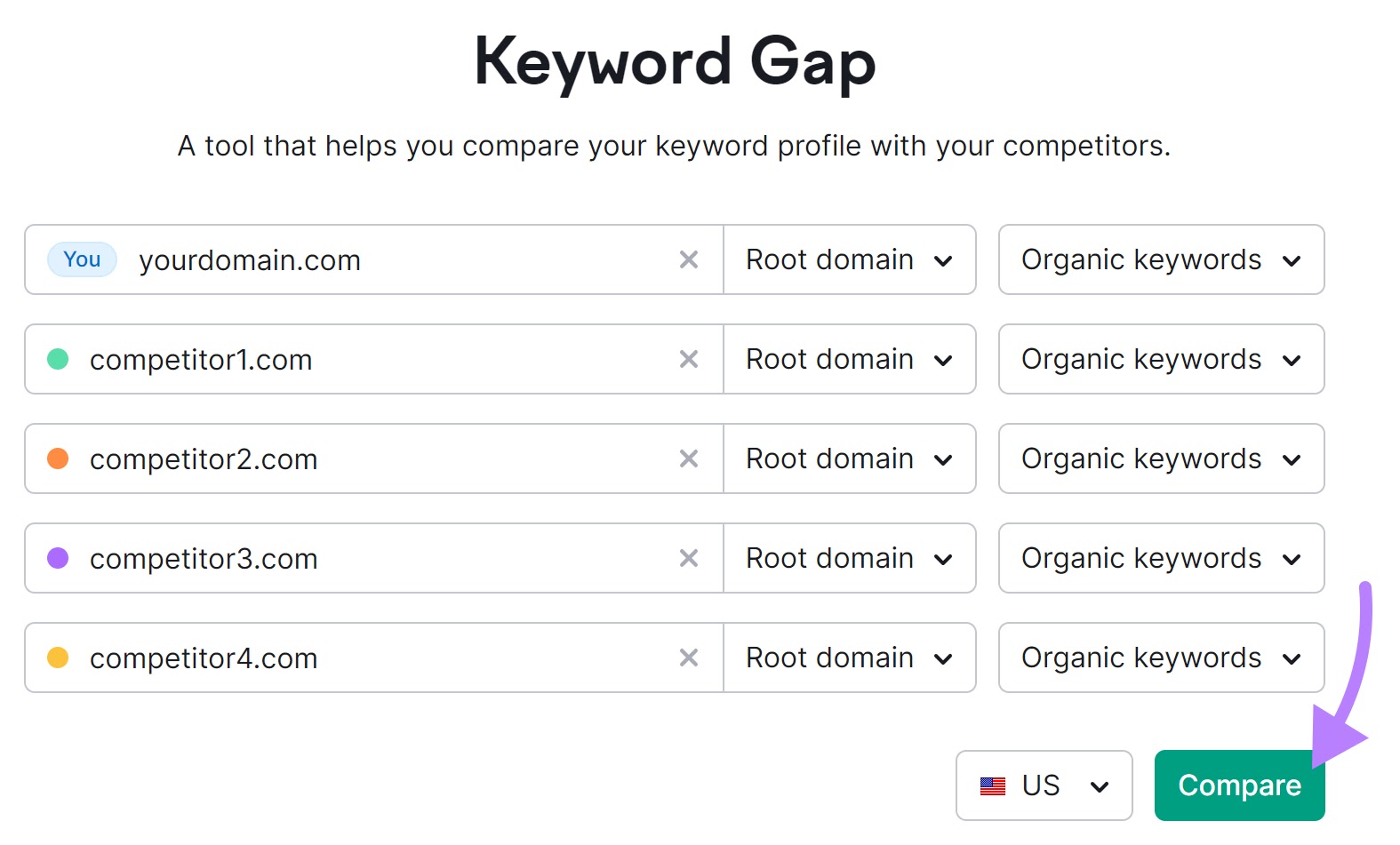
The tool will generate report you can filter for one of three options: “Organic keywords,” “Paid keywords,” and “PLA keywords” (which are product listing ad keywords).
With “Organic keywords” selected, you’ll see keyword opportunities for your website and a visualization of the keyword overlap with your competitors.
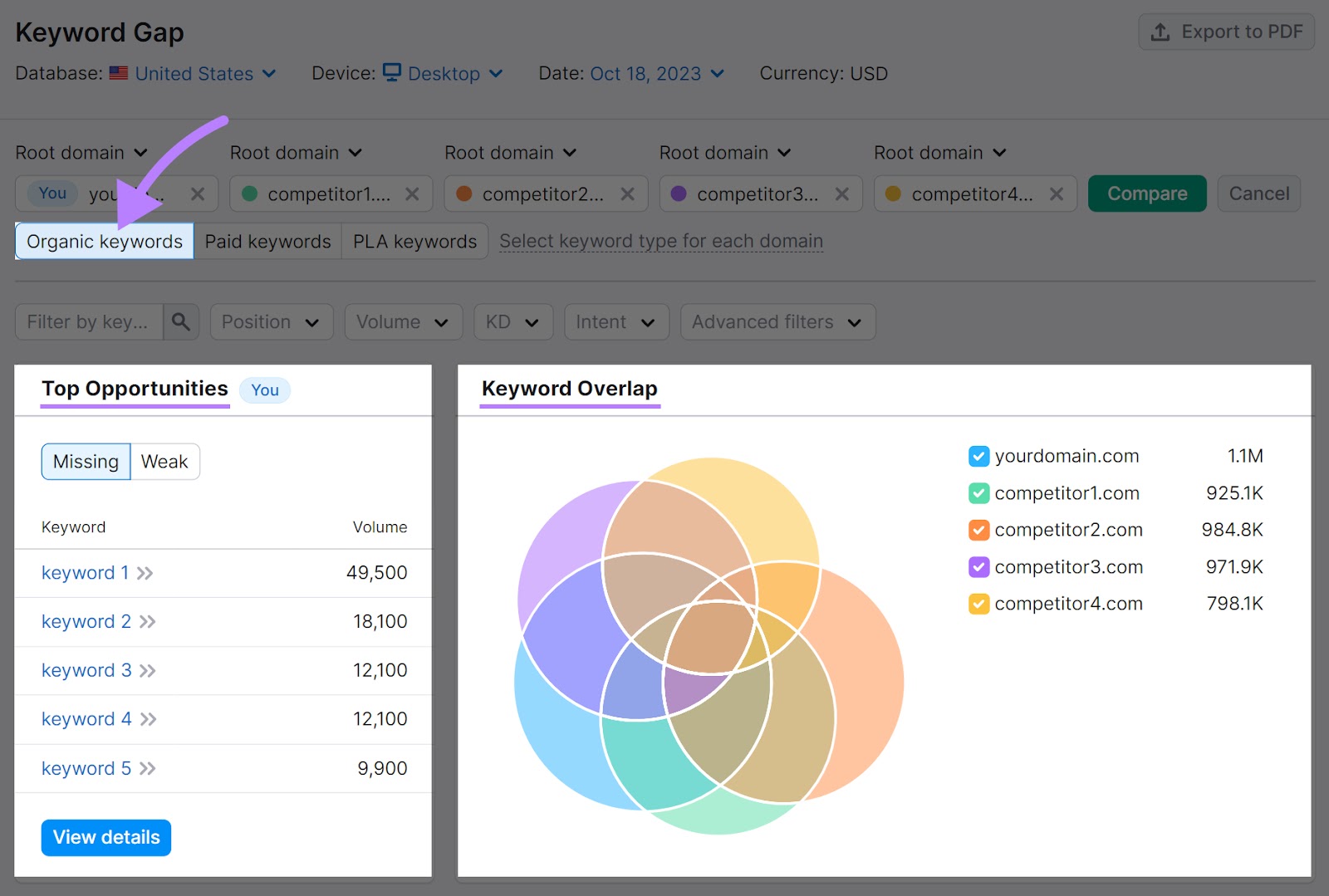
If you scroll further down and select the “Missing” tab, you’ll see all the keywords your competitors rank for but you don’t.
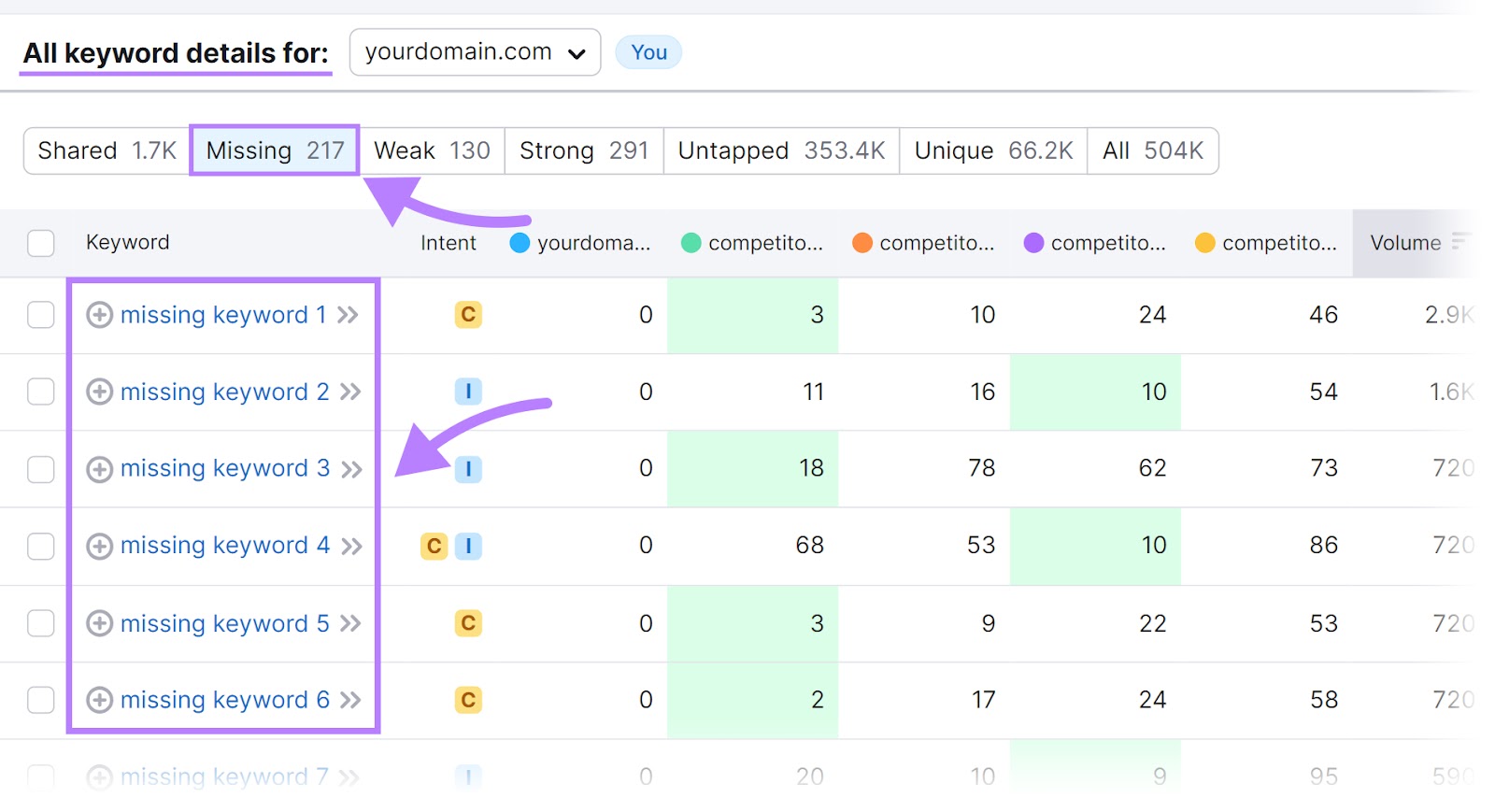
You can filter the table by using the provided tabs:
- Shared: The keywords shared by all your competitors and your website
- Missing: Keywords for which all your competitors rank but you don’t
- Weak: Keywords you rank for but those rankings are lower than that of your competition
- Strong: Keywords for which you rank higher than all your competitors
- Untapped: Keywords you don’t rank for but one of your competitors does
- Unique: Keywords you rank for that none of your competitors rank for
- All: A combined list of all the keywords you and your competitors rank for
From here, you can download the generated keyword list as a CSV or XLS file. Or send it to Semrush’s Keyword Manager.
If you decide to send your list to Keyword Manager, you can gather real-time metrics on all the keywords on the list. Or, turn the list into organized keyword clusters.
What We Like
The “Top Opportunities” section at the top of the page shows you the best keywords you should target at a glance based on an analysis of your competitors.
6. Backlink Gap
- Best for: Analyzing competitors’ link profiles to identify good backlink opportunities
- Free version available: Yes
- Pricing: Pro ($129.95/month); Guru ($249.95/month); Business ($499.95/month)
The Backlink Gap tool allows you to analyze your competitors’ backlink profiles and uncover valuable backlinks (links from other sites that point to your site) you should try to acquire for your website.
To get started, enter your domain and the domains of up to four competitors. Then, click the “Find prospects” button.
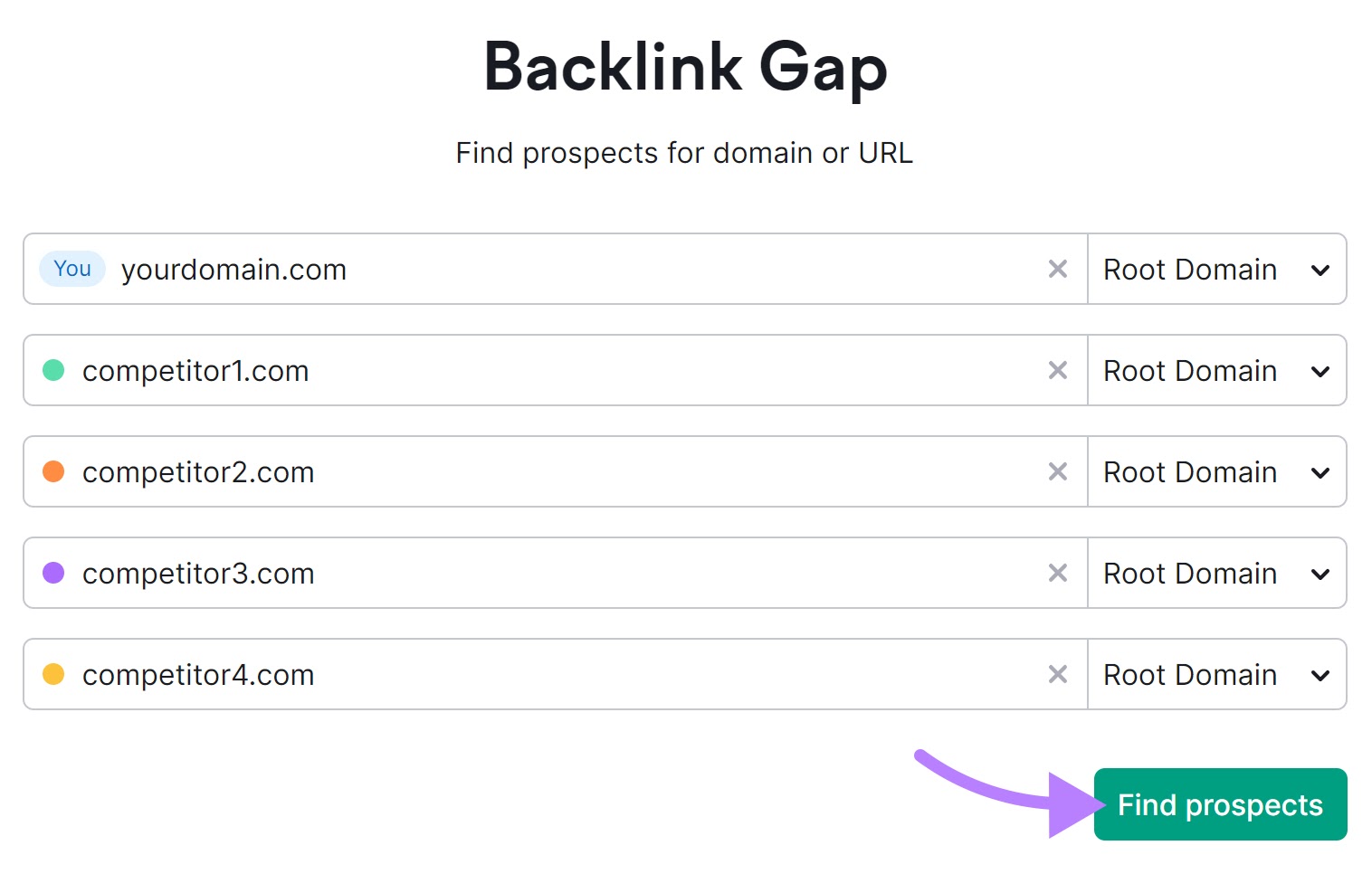
The tool will then analyze your and your competitors’ backlink profiles. And provide you with a list of backlink opportunities.
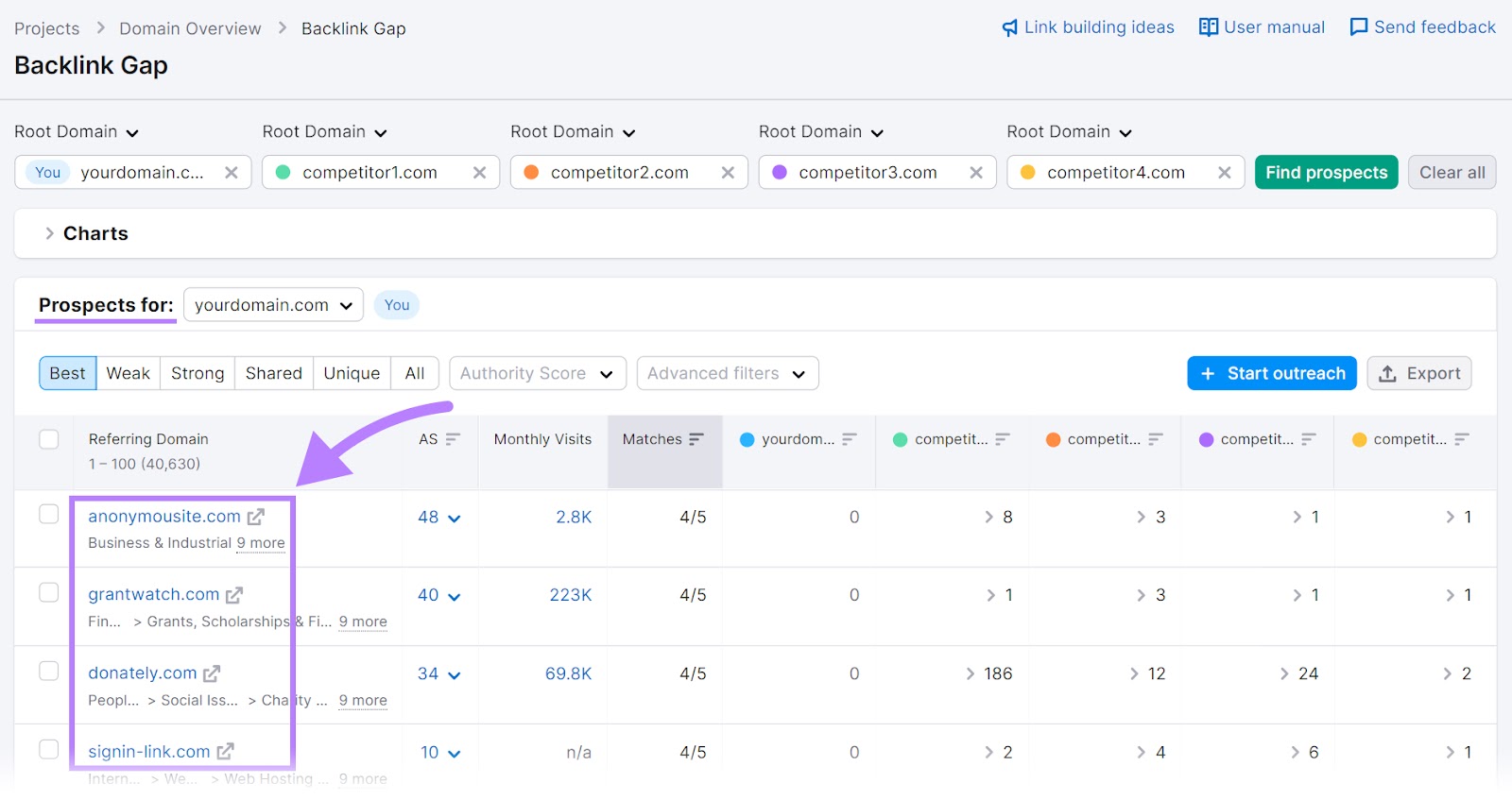
What We Like
There are extensive filtering features that allow you to consider backlink opportunities by traffic, Authority Score (a metric that indicates a site’s overall reputability), and other metrics to help you prioritize opportunities.
7. Social Tracker
- Best for: Tracking competitors’ social media activity
- Free version available: No
- Pricing: Pro ($129.95/month); Guru ($249.95/month); Business ($499.95/month) + $29.99/month
The Social Tracker tool makes it easy to track your competitors’ social media profiles. And learn more about their posting frequency and most popular posts.
It supports tracking social media activity across Facebook, Instagram, X (formerly known as Twitter), YouTube, and Pinterest.
Once you add your social profiles and the social profiles of your competitors to the tool, you’ll get access to a number of reports.
The first is the “Overview report,” which shows the overall performance of all the social profiles you’ve added to the tool. And you can switch between your company’s social profiles and those of your competitors by using the company selector drop-down.
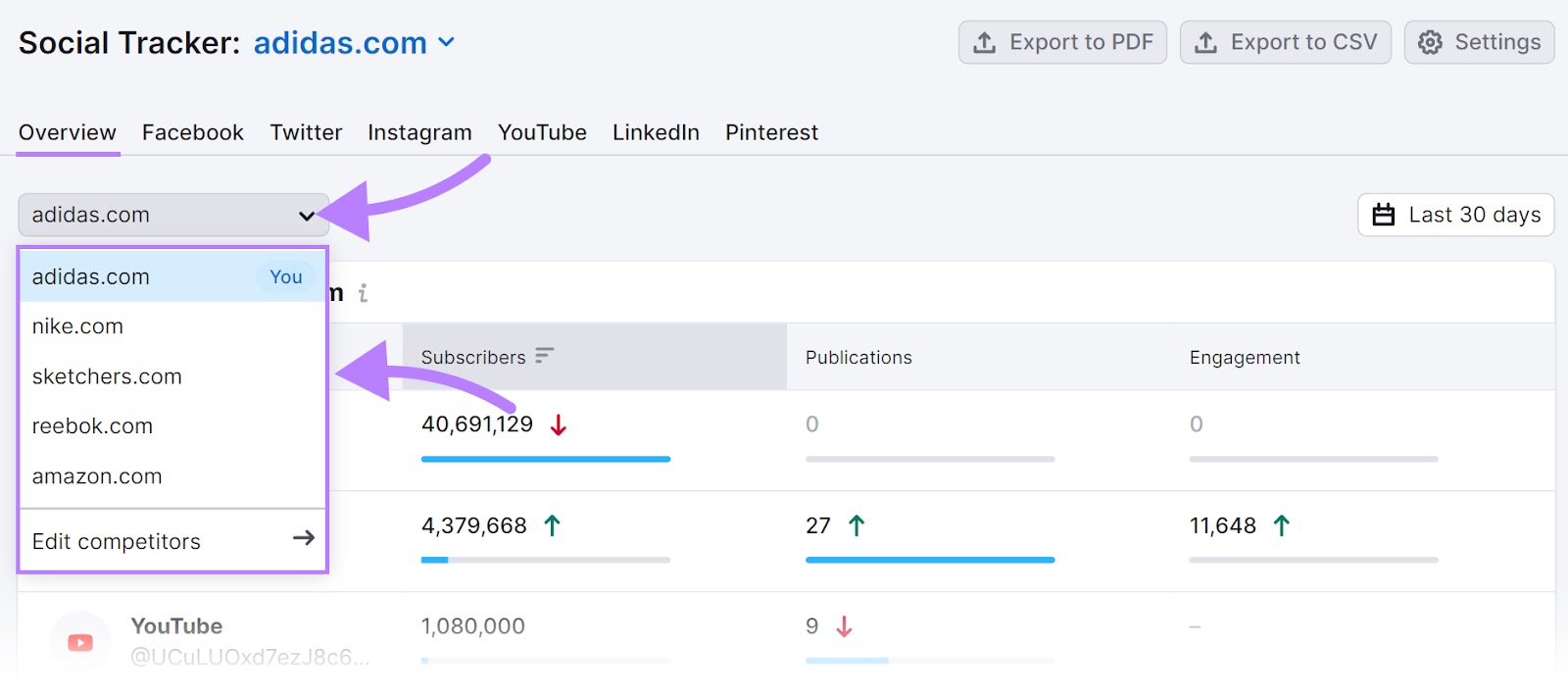
Here, you can see the total number of subscribers, publications, and engagements per channel.
If you scroll down to the “Top Content by Channel” section, you’ll see the top-performing social posts for the selected company. And you can sort the posts by total engagement or engagement rate.
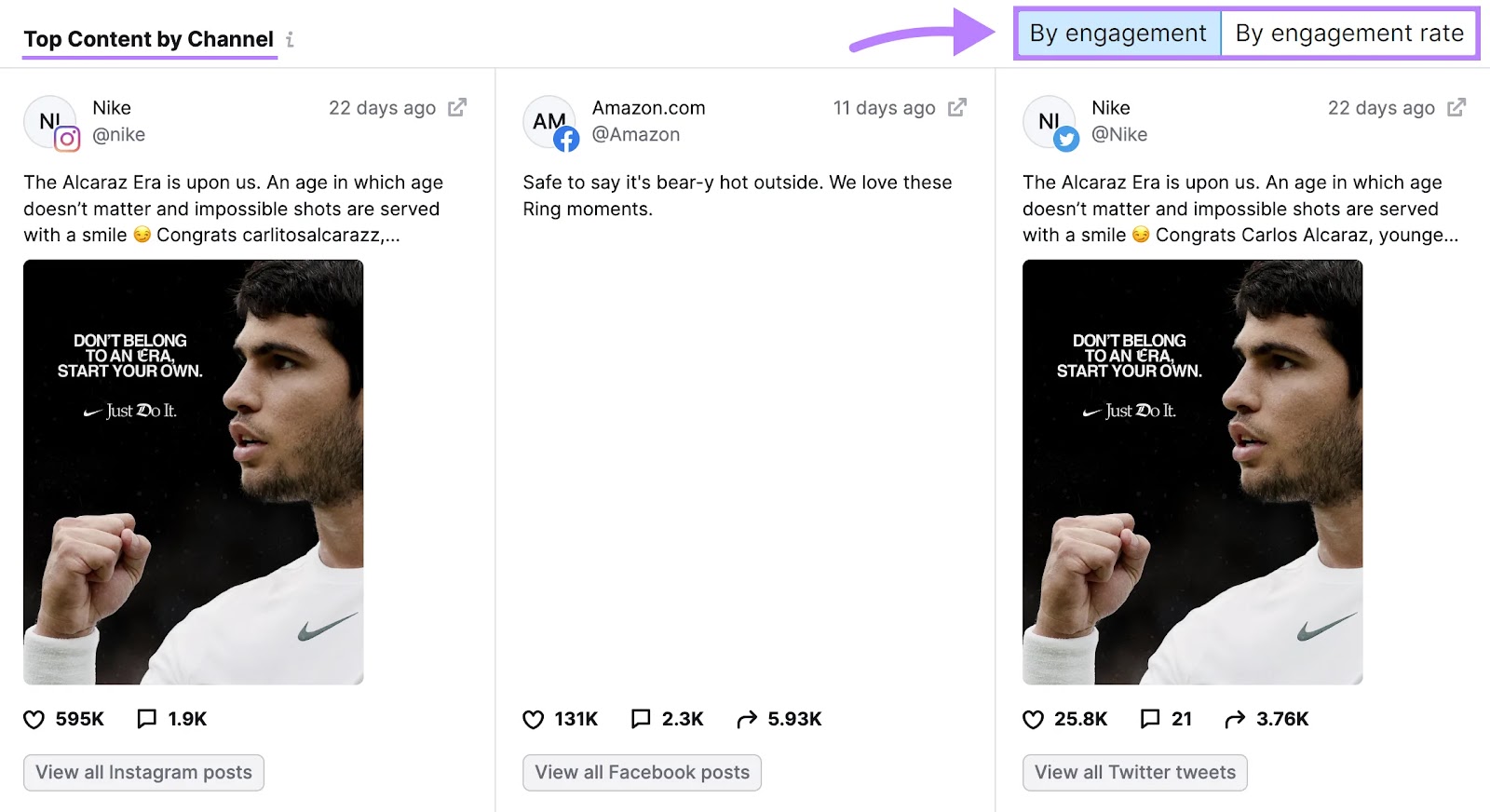
There’s also the “Comparison With Competitors” section, which shows how you fare against your competitors on three core areas: audience, activity, and engagement.
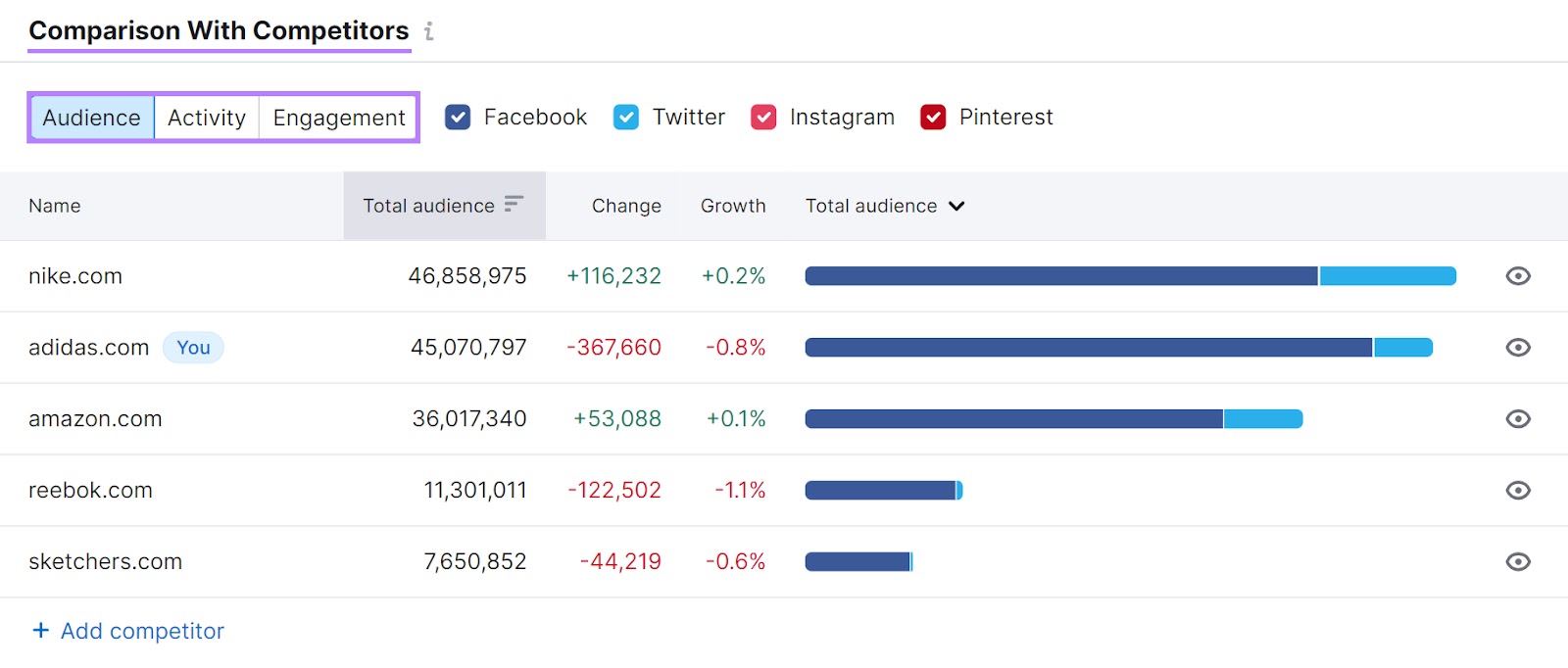
You also get dedicated reports for each social media channel.
For example, you can click on the “Facebook” tab to get an overview of your and your competitors’ Facebook activity, including posts, changes in audience size, and more.
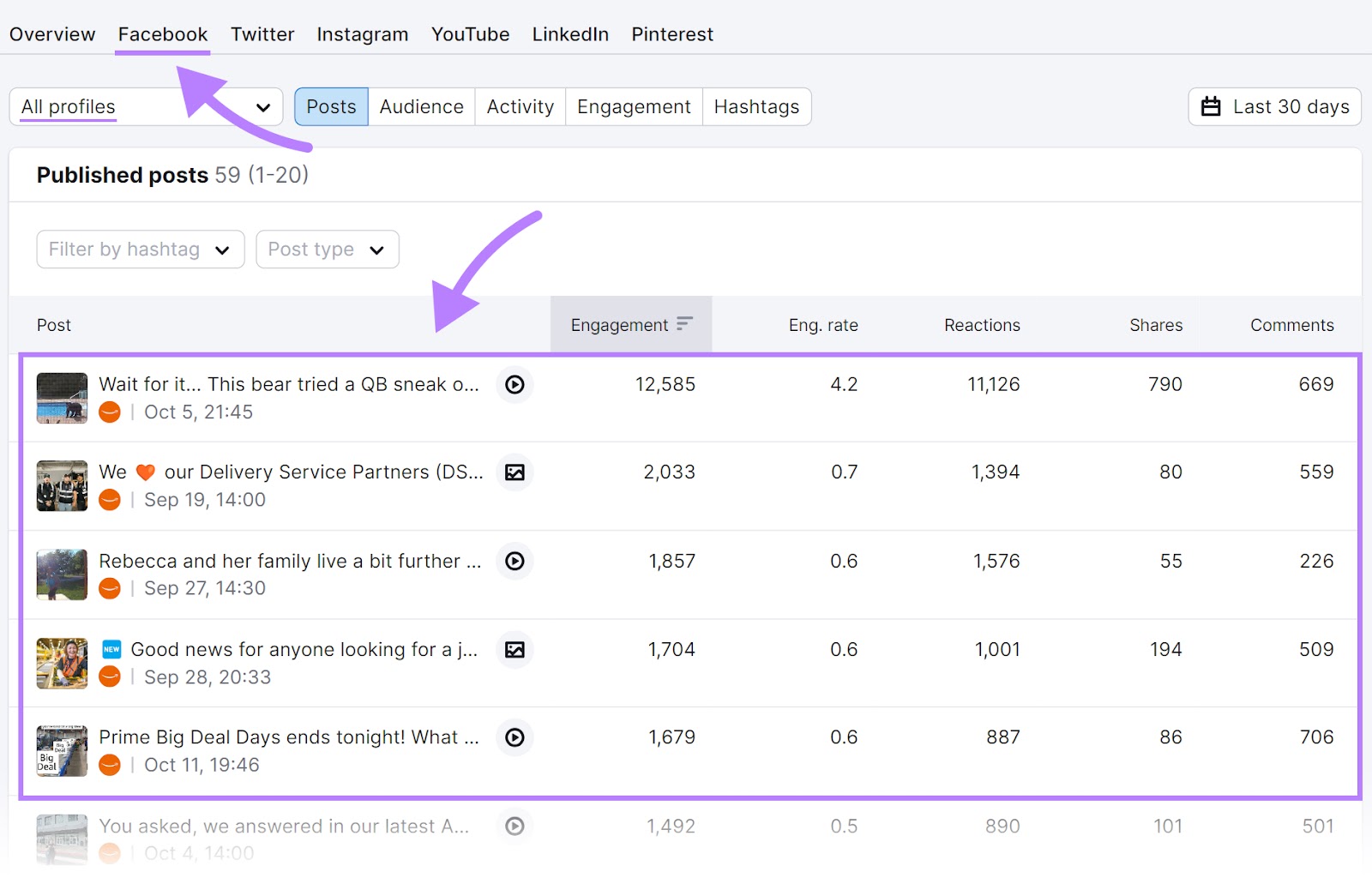
What We Like
This tool gives you the ability to drill down into your competitors’ social media activity on each individual channel. And deconstruct their social media strategy to optimize your own.
8. Klue
- Best for: Automated competitor monitoring and insight distribution
- Free version available: No
- Pricing: Not available publicly
Klue is a competitive intelligence tool that combines market, competitor, and buyer intelligence to provide teams with competitive insights.
Klue’s competitor research tools can help you track website changes, reviews, product launches, press and social media mentions, etc.
It then uses AI to analyze the data and surface the most relevant competitive insights for your team.
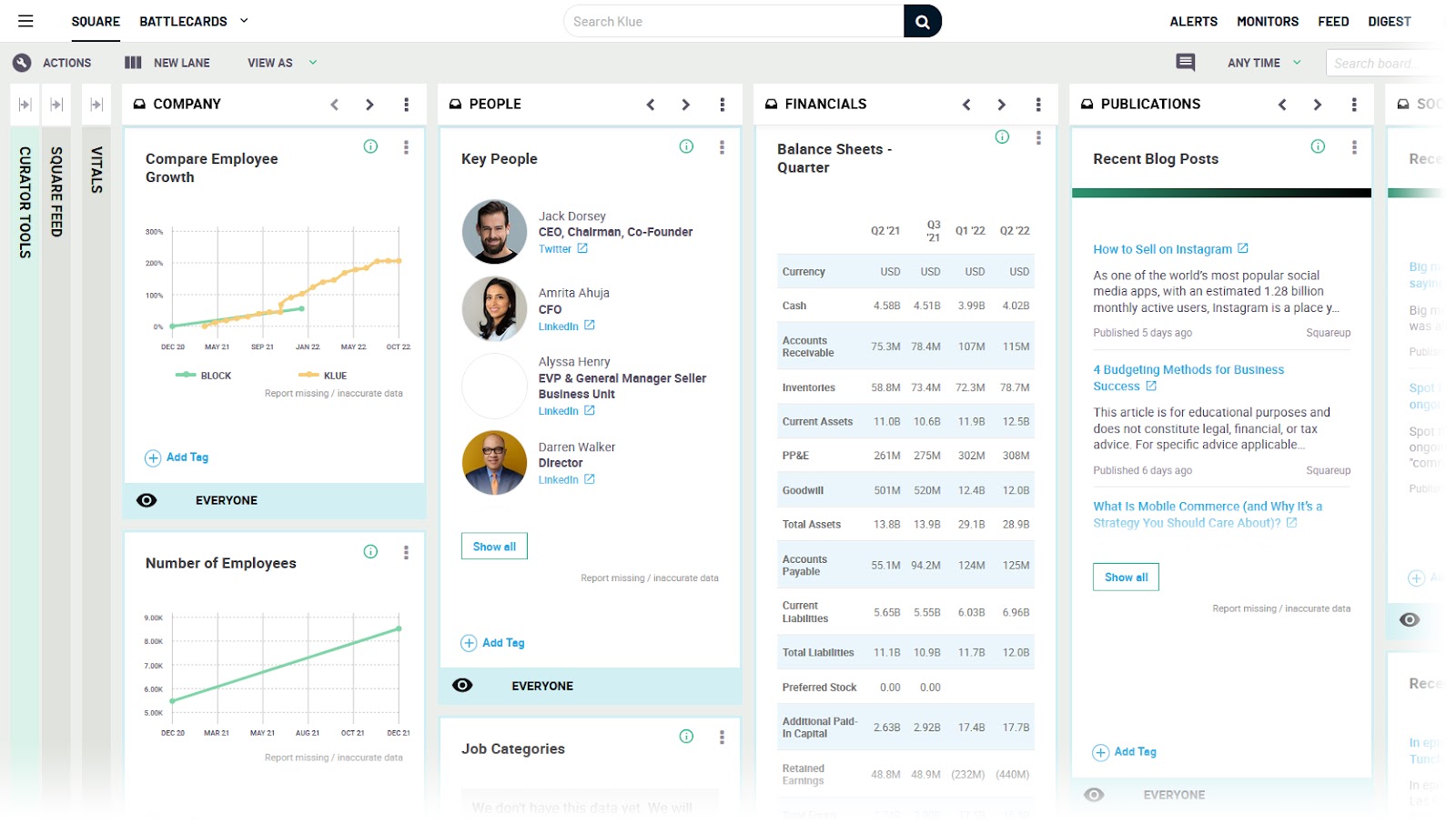
The software saves and tags intel automatically. To make it easy to search for relevant information you can use to create competitor profiles, plan marketing campaigns, and prepare for meetings.
Klue also allows you to measure how your team uses competitive content and its impact on revenue, deal win rates, and sales cycle length.
What We Like
Klue’s Triage mode lets you quickly review the latest competitive intel.
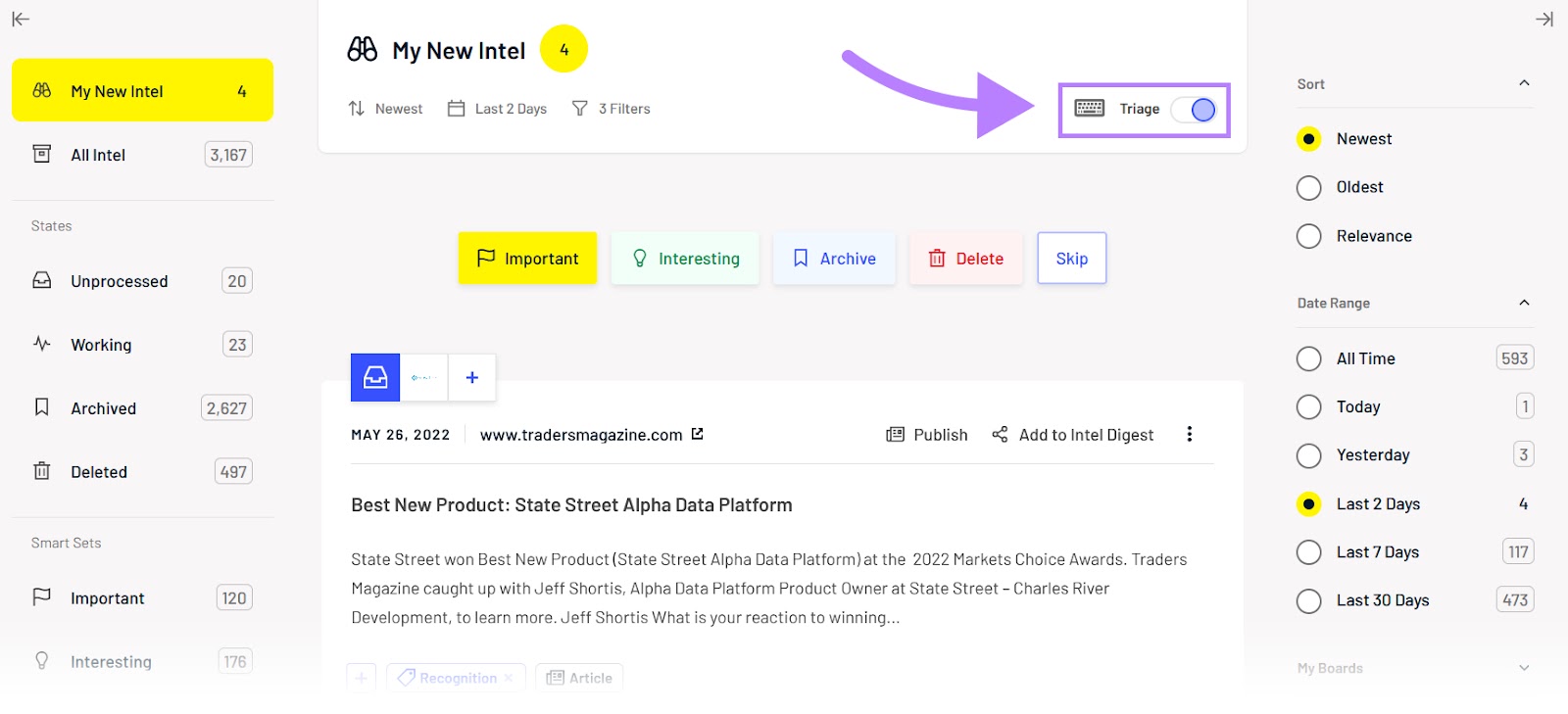
9. Brand24
- Best for: Tracking your competitors’ social media marketing efforts and brand mentions
- Free version available: No
- Pricing: Individual ($99/month); Team ($179/month); Pro ($249/month); Enterprise ($499/month)
Brand24 is a social listening tool that allows you to track brand mentions across many sources.
You can use it to find out what people are saying about your competition on social media, review websites, and other places on the web.
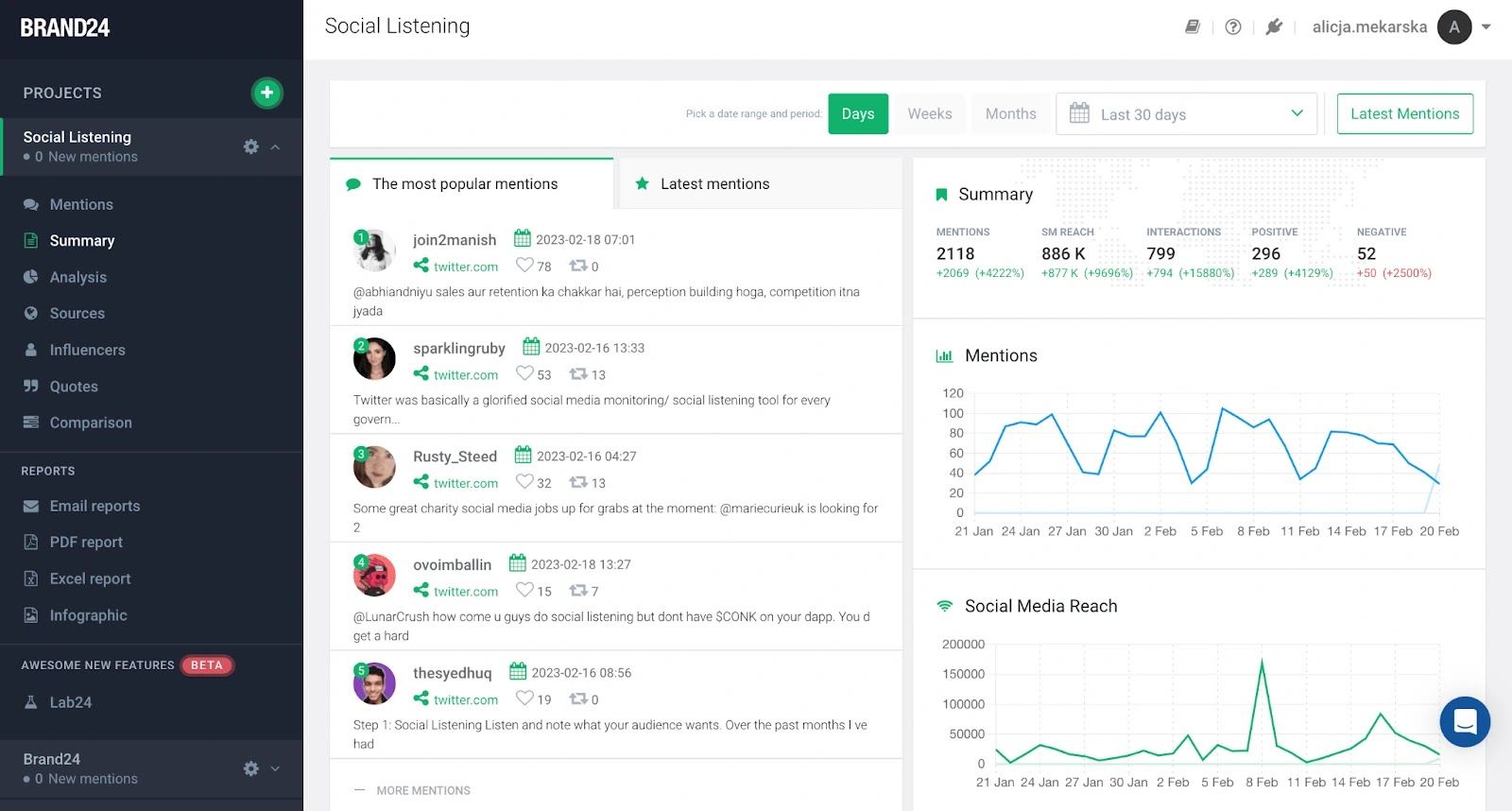
The software’s sentiment analysis feature helps you filter for negative mentions. To find people who are dissatisfied with your competition. And identify the issues they’re having with your competitors’ products or services.
There’s also an option to set up email and in-app notifications for competitor brand mentions. So you’re always in the know.
What We Like
Brand24’s Mentions feed allows you to review mentions in an easy-to-use display and engage in relevant discussions with a single click.
10. SpyFu
- Best for: Analyzing competitors’ PPC search campaigns
- Free version available: No
- Pricing: Basic ($39/month); Professional ($79/month); Team ($299/month)
SpyFu’s competitor tracking features can help you analyze your competitors’ SEO and paid search efforts.
You can use it to learn more about:
- The keywords your competitors rank for
- The traffic they generate from SEO
- Their backlink profiles
- Their paid search ads and the keywords they bid on
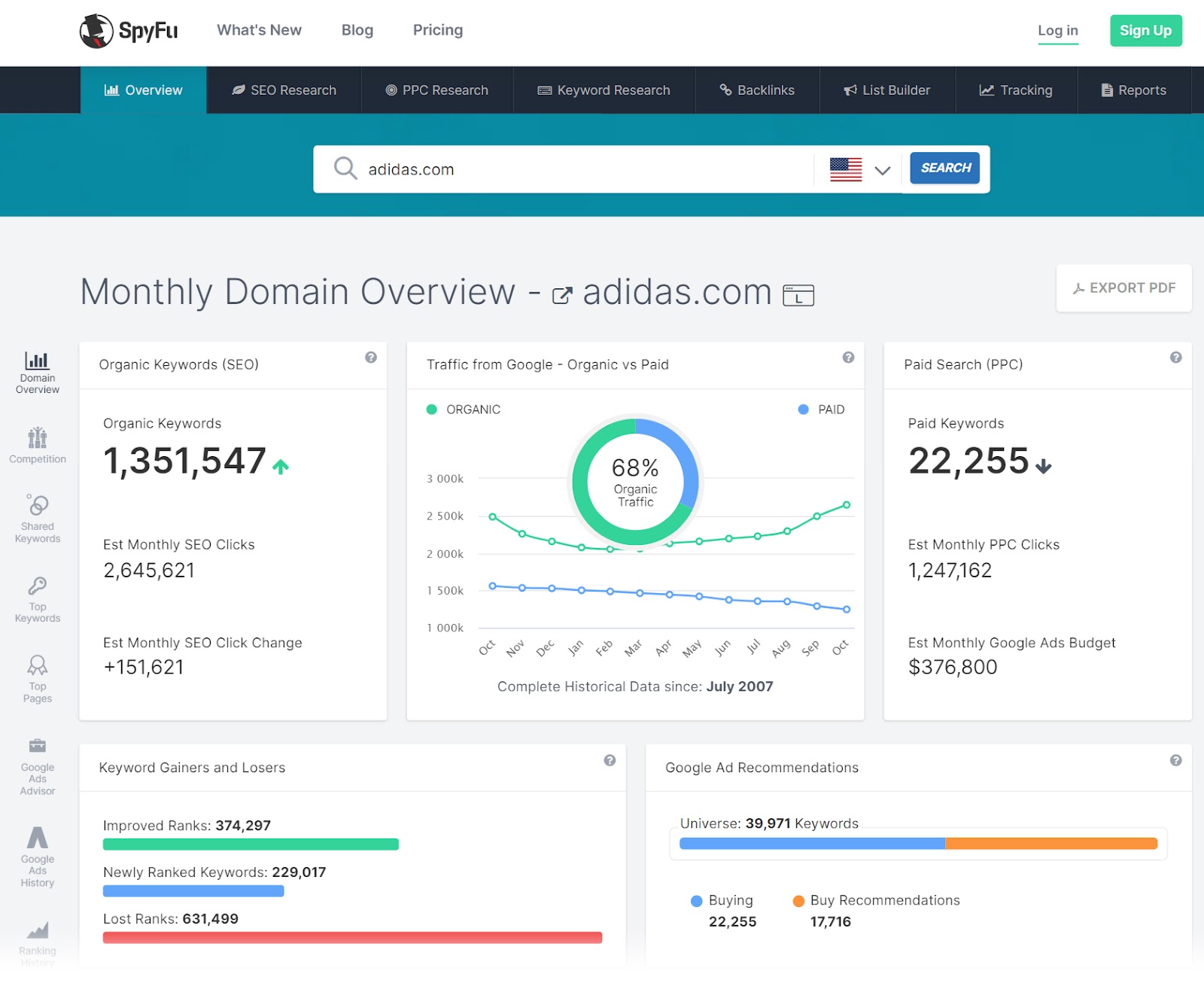
The software can also provide recommendations for those main categories.
What We Like
SpyFu offers unlimited searches and data downloads on every plan.
11. MailCharts
- Best for: Analyzing ecommerce brands’ email marketing strategies
- Free version available: Yes
- Pricing: Pro ($149/month); Enterprise (custom pricing)
You can use MailCharts to analyze your competitors’ email marketing campaigns.
The software lets you review email sequences to help you understand how your competition is nurturing customers.
MailCharts’ database contains examples of transactional and triggered emails from thousands of brands. And offers a search and filtering feature that helps you find the types of emails you’re looking for.
You can also comment on specific email examples and add them to lists that you can revisit later for research or inspiration.
There’s also the option to create a group containing all your competitors. To analyze similar competitors within the group and provide you high-level insights on common subject line terms, sending behavior, and other benchmarks.
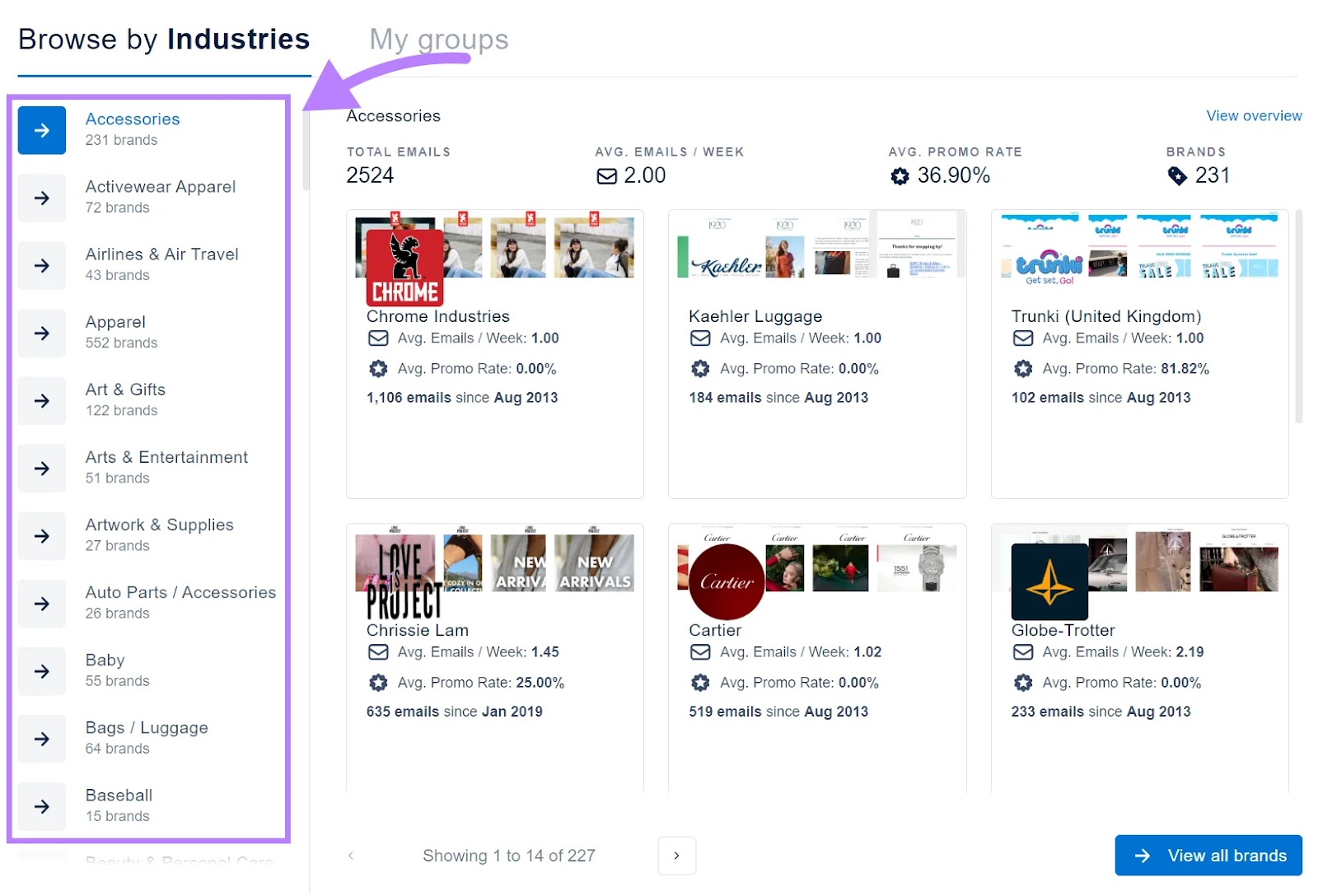
What We Like
MailCharts has a database with years of email data that lets you analyze historical changes in your competitors’ email marketing strategies.
12. Owletter
- Best for: Collecting and analyzing competitor emails
- Free version available: No
- Pricing: Starter ($19/month); Pro ($39/month); Unlimited ($79/month)
Owletter helps you analyze competitors’ email marketing strategies by capturing and storing all their emails.
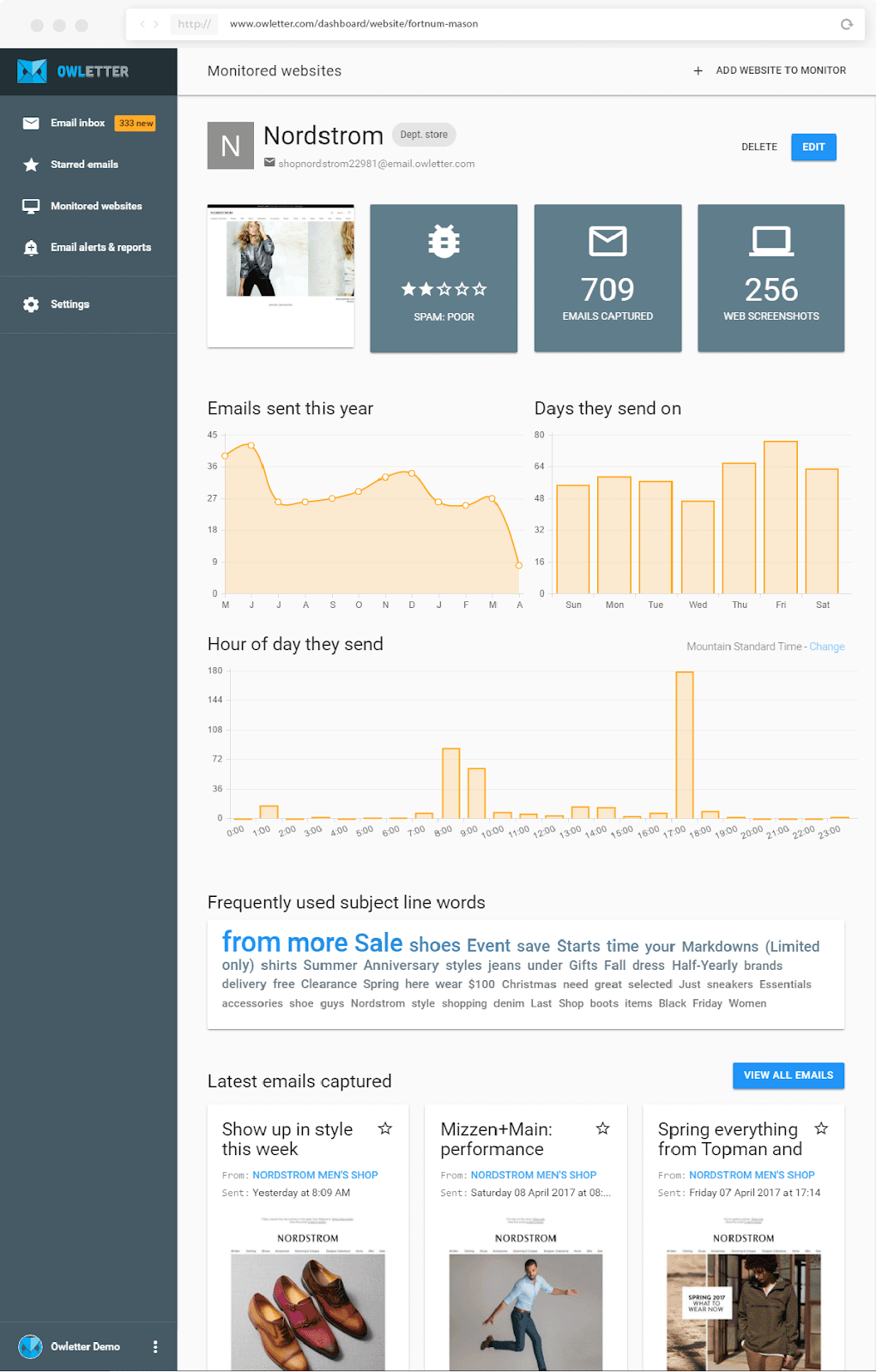
Image Source: Owletter
The software can also provide you with insights like your competitors’ email sending frequency and send times.
There’s also the option to set up alerts to get notified when a competitor sends an email containing keywords you specify.
What We Like
Owletter sends you a monthly roundup of all the emails sent by your competitors. So you don’t have to subscribe to each competitor’s newsletter manually using your email address.
13. SendView
- Best for: Detailed insights on your competitors’ email marketing strategies
- Free version available: No
- Pricing: Standard ($69/month); Pro ($99/month); Ultimate ($169/month); Agency (custom pricing)
SendView is another tool that helps you stay on top of competitors’ email marketing tactics.
It allows you to review your competitors’ email marketing calendars at a glance and gain insight into their email marketing tech stack.
SendView will generate a tracking email address for each competitor you decide to track. And you can view the source code for each email tracked.
Once the tool gathers enough emails, it will identify common send times, email sending frequency, and more to help you improve your email marketing strategy.
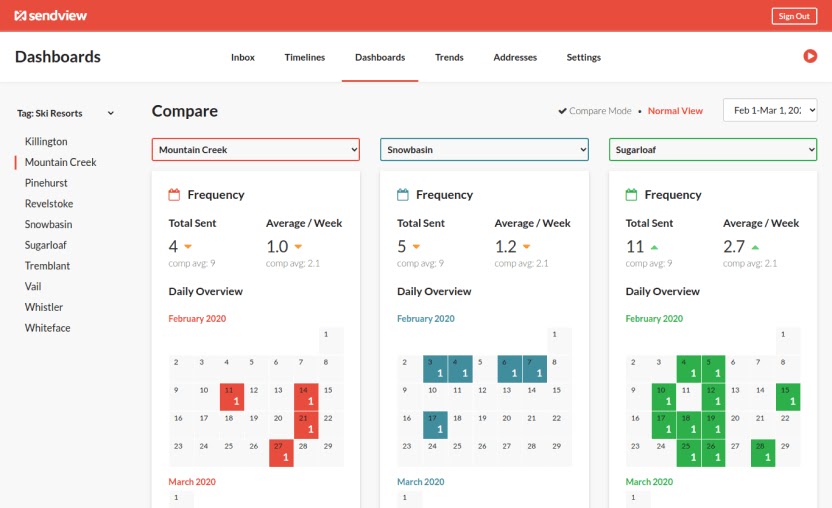
Image Source: SendView
What We Like
The advanced search capabilities help you filter campaigns by email service provider (ESP), send time, word count, tracking code, etc.
14. Visualping
- Best for: Tracking changes on competitors’ websites
- Free version available: Yes
- Pricing: Business 5K ($35/month); Business 10K ($70/month); Business 20K ($140/month); Business 30K ($210/month); Business 40K ($280/month); Business 50K ($350/month)
Visualping is a website monitoring tool that can help you track changes on competitors’ websites by entering their URL into the search bar.
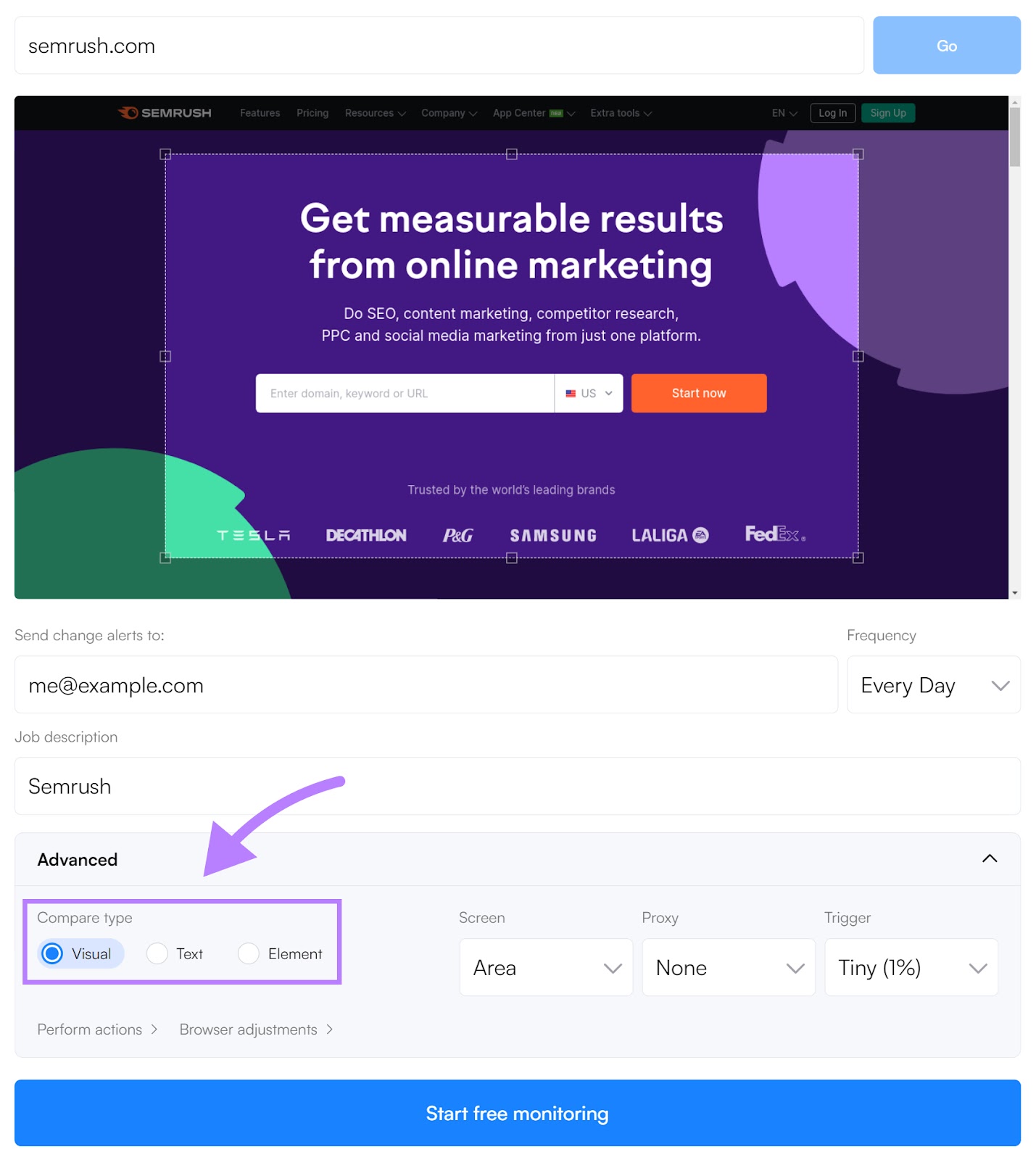
The tool can be used to stay on top of competitors’ product updates, promotions, messaging, and call-to-action (CTA) changes.
You can monitor an entire page or specific page elements.
There’s also the option to set up email alerts to get notified as soon as changes occur.
What We Like
Visualping’s Chrome extension lets you do page monitoring via your browser for free.
15. iSpionage
- Best for: Analyzing your competitors’ PPC search campaigns
- Free version available: Yes
- Pricing: Starter ($59/month); Professional ($99/month); Advanced ($299/month); Enterprise (custom pricing)
iSpionage’s competitor marketing analysis tools help you monitor competitors’ organic search rankings and paid search campaigns.
You can use iSpionage to track your keywords and gain access to up to 24 months of historical data on search rankings. There’s also the option to benchmark your search rankings against those of your competitors.
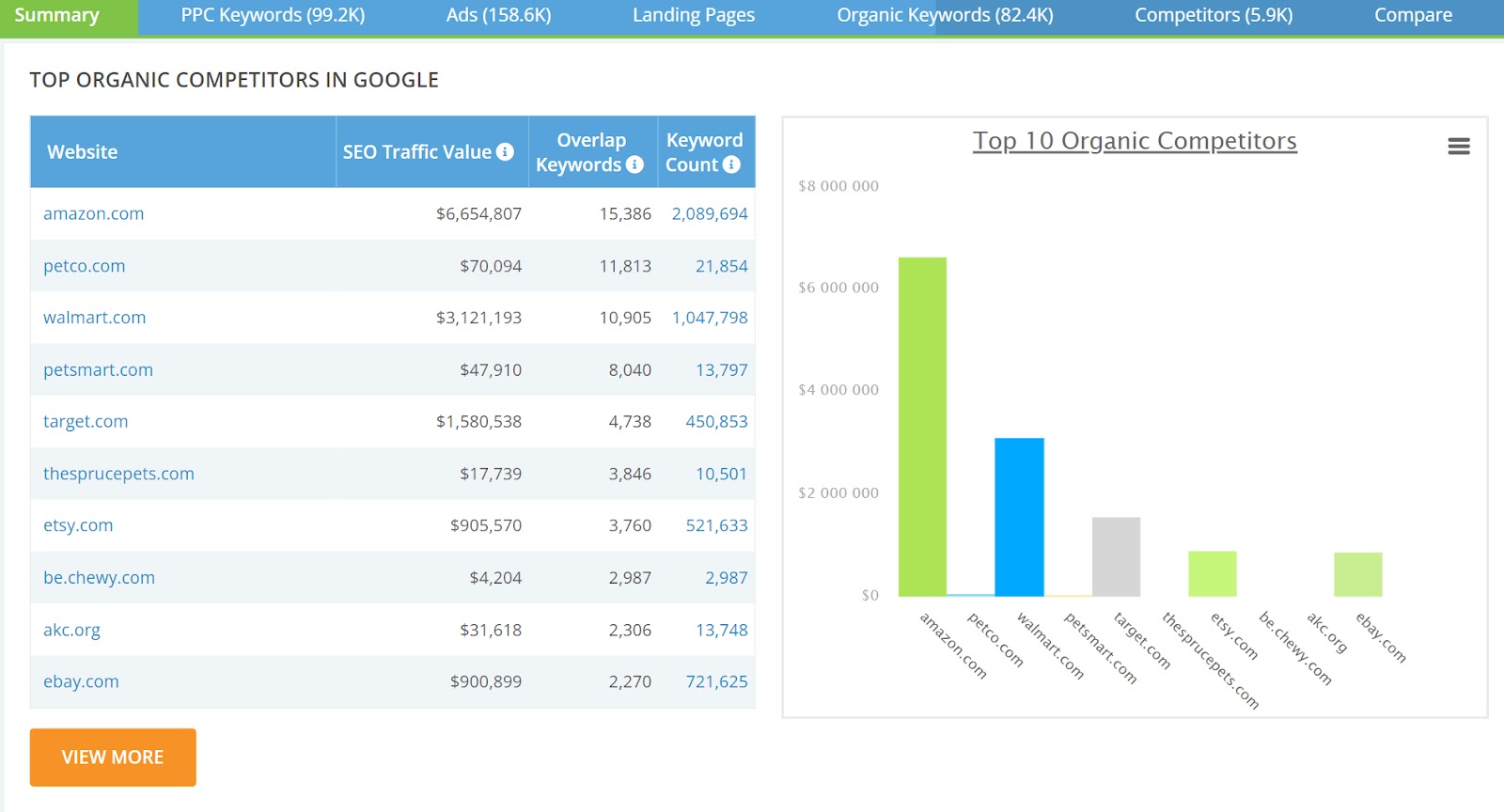
iSpionage can provide you with insights into your competitors’ overall PPC strategies by letting you see the search terms competitors are bidding on and the conversion paths their users take.
The software can also show you the results of competitors’ A/B tests and enable you to set up email alerts to notify you about changes competitors make to their campaigns.
What We Like
iSpionage’s Keyword Effectiveness Index helps you find the most profitable keywords to bid on in your PPC search campaigns.
16. STAT
- Best for: Detailed SEO competitive analysis
- Free version available: No
- Pricing: Starts at $720/month
STAT is an enterprise search analytics platform that can help you stay on top of your competitors’ SEO strategy.
You can use it to identify your competition in the SERPs and track an unlimited number of competitors and keywords.
The software also lets you chart brand exposure and benchmark against competitors with the Share of Voice report and chart.
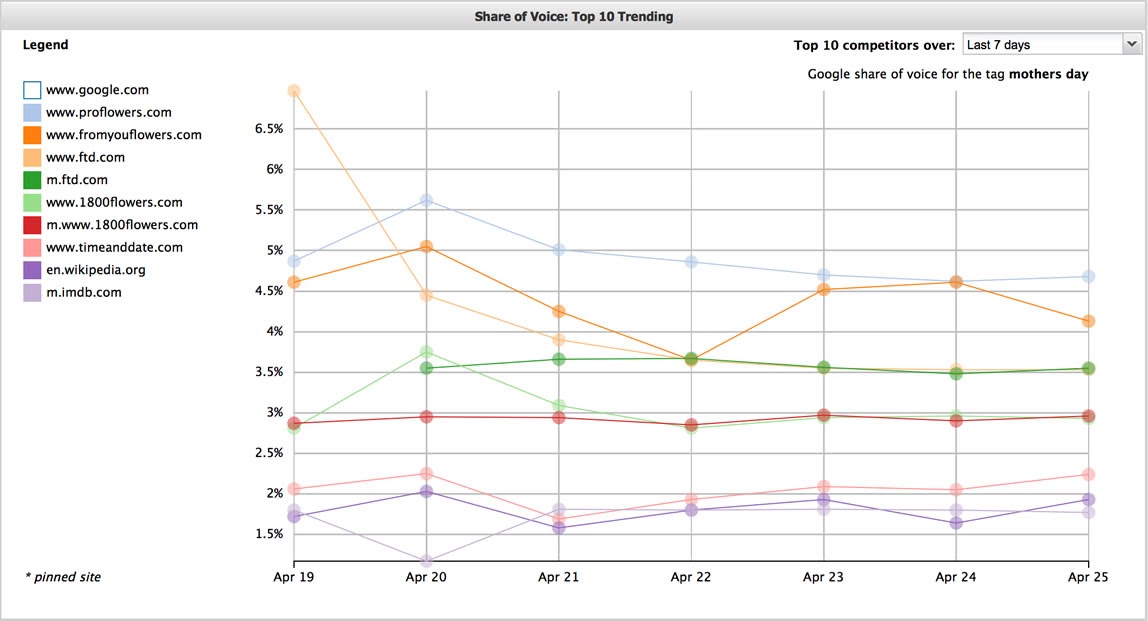
Image Source: STAT
What We Like
STAT lets you set up custom alerts to let you know when competitors’ websites drop in rankings, lose backlinks, etc.
Use Competitor Monitoring Tools to Improve Your Marketing Strategy
Gain an edge over the competition by leveraging competitive monitoring tools to enhance your marketing strategy.
Here are a few ideas to get started right now:
- Address content gaps: Generate a list of all the keywords your competitors rank for but you don’t with Semrush’s Keyword Gap tool. Create a content plan to target these keywords with specific content pieces.
- Uncover backlink opportunities: Use Semrush’s Backlink Gap tool to find domains linking to your competitors’ websites. Strategize ways to acquire backlinks from these domains for your website.
- Improve your ad campaigns: Use the Advertising Research tool from Semrush to learn more about your competitors’ advertising campaigns. Take advantage of the insights to bid on more profitable keywords and improve your ad copy and landing pages.
Sign up for a free trial to get started today.
